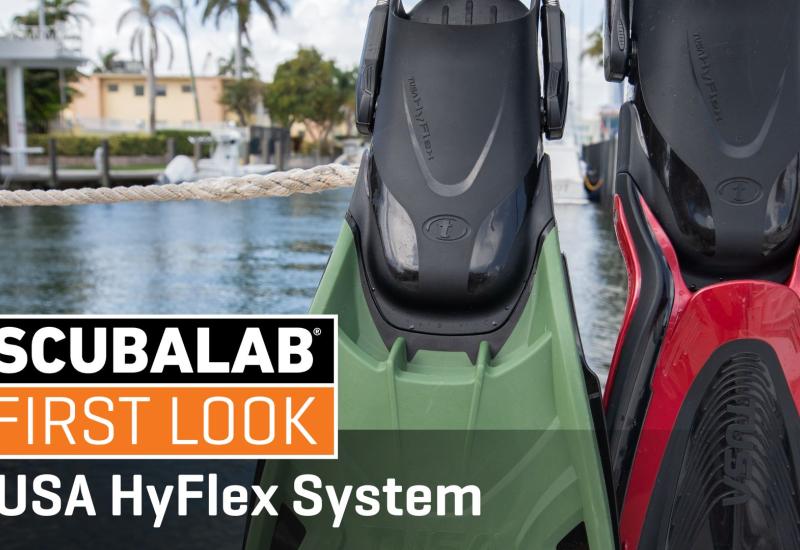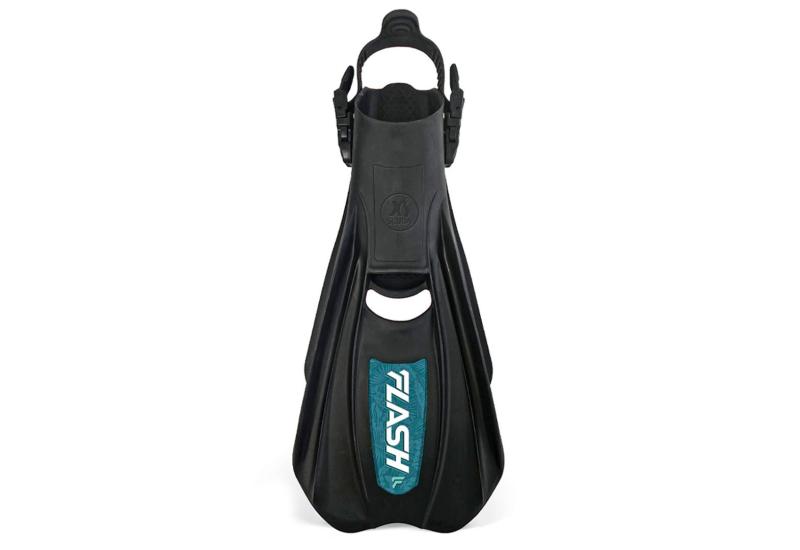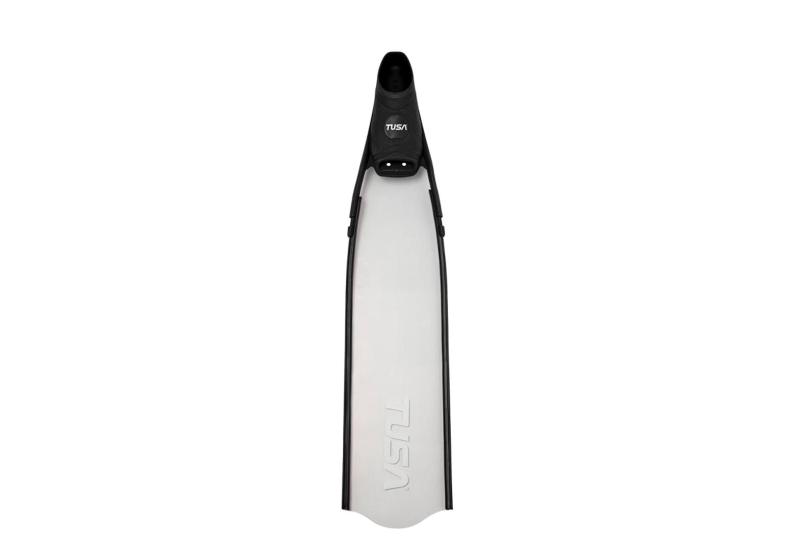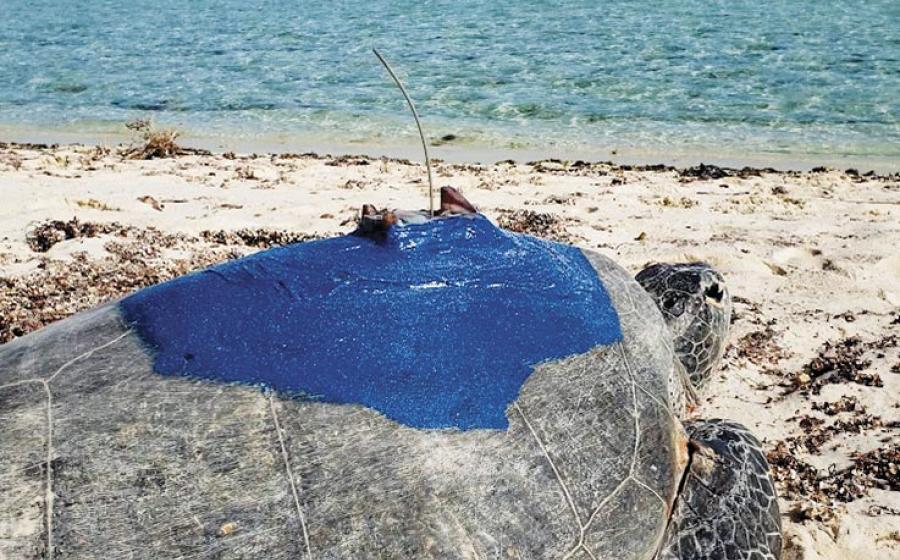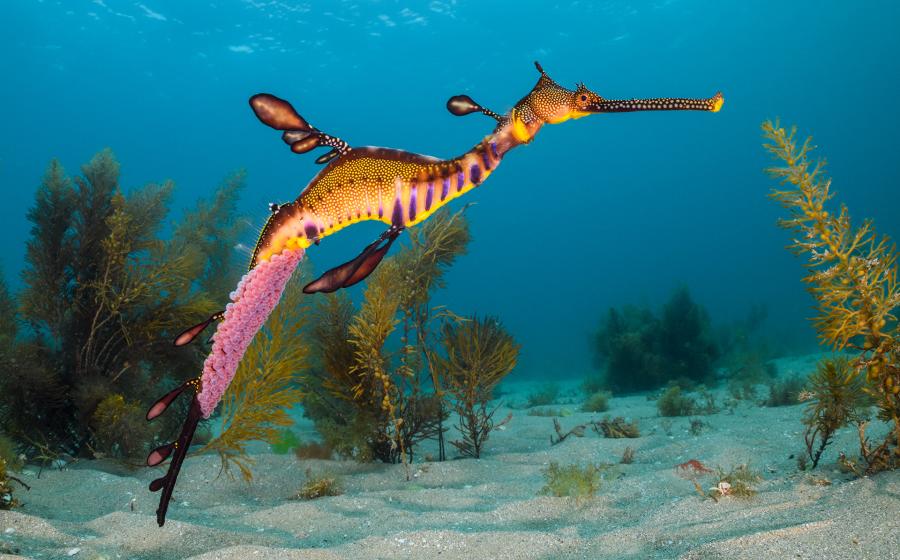2005 Fin Test
| 2005 Fin Test: Protocols 2005 Fin Test: Behind the Scenes Scuba Lab: 2005 Fin Test (PDF--192k) |
October 2005
By John Brumm
Photography by Chris Parsons
||
|---|
|

|
| Test diver Riza Lacour burns up the speed course, measuring a fin's top speed with a digital underwater speedometer.|
Scuba Diving's Scuba Lab staff and fin test team assembled this year at Capt. Don's Habitat on Bonaire, just itching to get wet. In our fourth year of fin testing, the team--two-thirds male, one-third female, all Scuba Diving readers--had once again bid farewell to jobs, family and friends to devote five days of their lives to seeking out the best new foot rockets. As the T-shirt says, it's a tough job, but somebody has to do it.
This year's test bed included a total of 16 fins: 10 open-heel models and six full-foots. Most were either new, redesigned or rebranded since last year's tests; a few fins were not new but had never been reviewed before. For comparison, we also included a couple of classic fin designs that have been around as long as many divers have been alive. We wanted to see if they could compete, kick for kick, with the latest in fin technology.
A Full Test Schedule
Tests were comprised of rigorous morning objective tests, followed by afternoon ergonomic dives out on the reefs. Morning tests included speed runs with specially designed underwater digital speedometers, thrust tests using a kicking harness attached to a spring-loaded scale, slalom runs conducted on a staked course, and straight-line efficiency course runs timed with digital stopwatches. Afternoon dives gauged how the fins behaved in real-world diving situations. Test divers used preprinted waterproof test sheets on underwater slates to score each fin in 10 specific performance categories--how a fin maneuvered down on the reef, how stable it was when kicking hard, how comfortably it fit, etc.--then supplemented their scores with written comments.
By week's end, we'd put in a total of 195 underwater hours on the objective tests alone, and collected 1,920 data points. And our divers collectively made another 180 afternoon dives, generating 1,800 additional data points and pages of written comments.
Following is a rundown of what we discovered.
Open-Heel Fins - Testers' Choices
This year's four top open-heel kickers ran well ahead of their rivals in the "most important" ergonomic tests. Combined with Good to Excellent scores on the objective performance measurements, these fins earned the highest total scores in their class.
APOLLO SPORTS Bio-Fin Pro Yellow/C-Series
||
|---|
|

|
| APOLLO SPORTS Bio-Fin Pro Yellow/C-Series|
How do you improve on a fin that's already just about perfect? By increasing its size range and adding a spring strap. Apollo's C-Series commercial-grade stainless-steel coil spring through-bolts to backing plates and couldn't be any more rugged. Test divers loved it.
The fin itself is equally impressive. Its 100 percent natural rubber construction provides a butter-soft foot pocket that feels molded to your foot. It's the only fin in this year's competition to earn an Excellent rating for comfort. But while it may fit like a favorite slipper, it doesn't behave like one. The Bio-Fin Pro Yellow/C-Series outraced all comers on the speed test, muscled top score out of the thrust test and easily dusted the competition on both slalom and efficiency courses.
When test divers took it out for some real-world diving, it dominated there too. Generating snorkel-bending acceleration, stability at high speeds and a nimbleness that had everybody talking, this pliable fin racked up the highest total ergo score. As the only open-heel fin rated Excellent for power, for acceleration, for its efficiency with alternate kicks, as well as for comfort, it's easy to see why the Bio-Fin Pro Yellow/C-Series is this year's top overall open-heel fin.
Test Divers' Comments:_ "Spring straps make an already great fin even better." ... "This is the closest man is allowed to come to being a fish." ... "If these fins had reclining seats I'd trade my Jaguar in for a pair." ... "Very comfortable and no leg strain at all--even when swimming fast."_
AERIS Velocity Duo
||
|---|
|

|
| AERIS Velocity Duo|
The Velocity Duo returns this year with some changes in the EVA composite materials used to make its split blade. Based on our tests, these changes didn't create any radical improvement in performance, but that's OK, because the Velocity Duo was already a pretty impressive fin. Although it's not particularly top-end fast, the Duo is a go-getter out of the gate and it turned in above-average thrust test scores. It also gave a respectable showing on both slalom and efficiency courses.
It's out on the reefs where the Velocity Duo really hits its stride. Earning the second-highest overall score for ergonomics, test divers rated it Very Good in all the "most important" performance categories. The fin proved to be stable and maneuverable. It responded well to small corrections and could easily hold a diver in a stationary position for photography. It also showed itself to be a very good fin for alternate kicks, the frog kick in particular, and it can move some water when kicking on the surface. As far as comfort, while male test divers tended to be satisfied with the foot pocket, some female divers felt that it was a bit too wide for their feet, which created wobble. Except for that, the Velocity Duo was considered by all test divers to be an exceptional all-around reef fin.
Test Divers' Comments:_ "Reminds me of a comfortable pair of running shoes." ... "Very lightweight. Easy to use." ... "Comfy. Hard to tell I had fins on." ... "Good on the surface when kicking on the stomach." ... "Delivers the kicking ease of a split with the stiffness of a blade."_
MOR-FIN Blue VT-300B
||
|---|
|

|
| MOR-FIN Blue VT-300B |
OK, we admit it. We approached this fishy-looking fin with a bit of skepticism. But that only lasted until we got the Mor-Fin wet. Turning in better objective test scores than the majority of its competitors, the Mor-Fin Blue stayed right on the Apollo's heels in the speed and thrust tests, then refused to be shaken off on the slalom and efficiency courses. During afternoon ergo dives the fin proved to be, as one test diver put it, "surprisingly efficient." The fin is relatively lightweight and very easy to kick. It delivered solid power, and was able to slip in and out of tight spots with ease. The fin produces little effort on the up-kick, which can create a strange sensation, especially while flutter kicking. This just takes some getting used to, as does its tendency to side-slice due to its lack of side rails.
On the downside, the fin was dinged by some test divers who found the foot pocket too stiff. Also, the blades are slick and a little sharp-edged, making them tricky to hold onto at the surface. (Note: Mor-Fin is already in the process of making the fin with a less slippery surface.) Finally, the fin doesn't really have any nonskid--not the best situation on a wet boat deck. According to Mor-Fin, they're working on that too.
Mor-Fins come in three levels of stiffness, designated by color. The stiffest and most powerful are black, the softest and most pliable are yellow, and the blue falls right about in the middle. Mor-Fins are available in medium and extra-large, but more sizes are slated for the future.
Test Divers' Comments:_ "Feels really light and easy to kick." ... "Good for dolphin and frog kick." ... "Pretty nimble. Good maneuverability." ... "This fin does have some power." ... "Surprisingly efficient." ... "Good cruising fins." ... "Is it just me, or are these things funny-looking?"_
DEEP OUTDOORS Six-Gill
||
|---|
|

|
| DEEP OUTDOORS Six-Gill |
More than 15 years in development, the new Six-Gill fin has a unique dual-directional water channeling system that, according to its maker, offers kicking power yet conserves kicking energy. The fin is shorter than most, and relatively lightweight, making it especially good for traveling.
The Six-Gill delivered mid-range results out on the objective test courses, then racked up the third-highest ergonomic score in this year's face-off. Test divers particularly liked its short, easy-to-wield blades, enabling them to get close to reefs while maintaining perfect control to avoid accidental contact with coral heads. It also proved to be a very stable fin, and a natural for divers partial to frog and dolphin kicks. However, the fin's nonskid provides only marginal traction on a wet boat deck.
The Six-Gill uses a super-simple strap system that eschews buckles. Pick the right adjustment slot on the strap, pop it over the fin post, and you're good to go. This system makes it hard to readjust while at depth, but if you did it right to begin with, you shouldn't ever have to readjust it under water. Test divers found the foot pocket to be very comfortable, in spite of the fact that at the time of testing it was available only in medium/large. Deep Outdoors says small/medium and large/extra-large sizes should be available by the time you read this.
Test Divers' Comments:_ "Straps are efficient--I like them." ... "Fins are shorter than average, which makes them easy to use." ... "I thought at first the straps were a little awkward, but they ended up working pretty well." ..."Very decent fin." ... "Good fin for the frog kick."_
Open-Heel Fins - Very Good Performers
Although these fins didn't earn enough points to earn a Testers' Choice designation, XS Scuba's Power Fin did deliver above-average performance in stability, comfort and alternate kicks, while Sherwood's Kinesis fins excelled in stability, donning/doffing and adjustment. Objective scores ranged from Fair to Very Good. The Power Fin also tied for highest thrust score.
XS SCUBA Power Fin
||
|---|
|

|
| XS SCUBA Power Fin |
This no-nonsense fin design has been around for more than 30 years and since it's still in circulation, we wanted to see if this classic could still compete.
Boy, were we surprised. First it pumped out a Very Good score for speed runs and also on the efficiency course, then collected a Fair score on the slalom course, then kicked into turbo mode to tie for the highest score in the thrust test. Out in real-world diving, test divers who've been blowing bubbles for a couple decades or more simply loved this fin. Newer divers, however, tended to be put off by the squat, relatively heavy, all-rubber design. But almost all test divers agreed that the Power Fin can get the job done. The fin is very stable at depth, offers good blade-end snap, and does exceptionally well with alternate kicks. Divers with cameras felt it was, as one put it, "super-easy to back up and maneuver when taking photos." The foot pocket is soft and comfortable, but the old-style strap system can be difficult to adjust. The upside is that once it's adjusted it stays adjusted, and there's nothing plastic to lose or break. The Power Fin's Very Good overall performance relative to price makes it a Best Buy.
Test Divers' Comments:_ "Of the entire grab bag of available fins, these are near the top." ... "These fins are heavy, no need for wearing weights." ... "Love these fins." ... "Dependable strap, but not easy to adjust." ... "Surprisingly good fin overall." _
SHERWOOD Kinesis and Kinesis EX
||
|---|
|

|
| SHERWOOD Kinesis and Kinesis EX |
These two fins, new to Sherwood, feature Optimal Pivoting Blade (OPB) technology to increase flex for maximizing thrust while not increasing effort. Relatively lightweight, the Kinesis, which comes in blue and yellow, is the standard version. The Kinesis EX, available in black only, is a stiffer fin, designed, according to Sherwood, for advanced divers seeking higher performance.
The two fins turned in decent straightaway speeds and did well on the efficiency course. Comparing the two fins to each other, the more flexible blade gave the standard Kinesis a slight advantage on the slalom course. When measuring thrust, the stiffer blade gave the EX a slight edge; however, compared to other fins, neither Kinesis was able to exert much force in the thrust test.
Out diving the reefs and cruising blue water, both fins proved to be very stable and comfortable. However, when test divers tried to turn on the kicking heat, they found it was easy to overstress their leg muscles. Some test divers found the blades a bit too long for maneuvering in close around reefs, but other test divers had no problem controlling the blades. All divers agreed that the fins were a cinch to get on and off, and they adjusted easily. Female test divers with smaller feet did find the foot pockets to be a bit too wide relative to their length, which caused some wobble.
Test Divers' Comments:_ "Decent fin for cruising." ... "Good on surface swims." ... "It's a pretty stiff blade--it strains the foot top and ankle." ... "It feels like you're kicking hard, but not moving very fast." ... "Efficient buckle system." ... "Overall, not a bad fin."_
Open-Heel Fins - Good Performers
These fins delivered satisfactory performance on the ergo dives, with the Aqua Lung Caravelle excelling in fit and comfort, the Dive Rite Fin excelling in donning and doffing with its spring strap, and the IST F-2 Talaria excelling in straight-line stability.
AQUA LUNG Caravelle ADJ
||
|---|
|

|
| AQUA LUNG Caravelle ADJ |
Available for years in a full-foot version, for 2005 Aqua Lung offers the Caravelle open-heel. This is a big fin with a lot of blade; test divers had a bit of difficulty with it when negotiating the sharp turns of the slalom course. On the other hand, while it takes some effort to get these fins going, the payoff is decent speed as well as thrust.
The Caravelle ADJ is not a bad fin out on the reefs. It turned in solid scores in the most important performance categories, plus was deemed to be above-average for fit and comfort. Divers also liked the easy buckle system, the extended heel and the nonskid.
Test Divers' Comments:_ "A bit of a long blade. You have to get used to it, but then it really is a nice fin." ... "Seems to go better with a slower, wider kicking stroke." ... "I find these fins very comfortable." ... "I like that they are lightweight."_
DIVE RITE Fin
||
|---|
|

|
| DIVE RITE Fin |
Although it proved to be one of this year's fastest open-heel fins, was powerful in the thrust tests and turned in some respectable times on both slalom and efficiency courses, this fin didn't generate much enthusiasm out on the reefs. Test divers rated the traditional paddle design as an OK all-round fin but nothing special. Made of injection-molded monoprene, the blade was considered a bit stiff, especially among female test divers. The fin has a spring strap, which was considered a plus, although divers felt it would have benefited from a grab loop. Still, it was a very easy fin to don and doff and needed no readjustment.
Test Divers' Comments: _"Spring strap is nice." ... "These fins hurt my ankles and feel like two steel plates on my feet." ... "Feels a bit clunky, but it's nimble." _
IST F-2 Talaria
||
|---|
|

|
| IST F-2 Talaria |
The F-2 Talaria turned in the lowest total score for objective test performance in this year's test, but that doesn't mean it can't get the job done. The fin's speed, thrust and efficiency course scores were middle-of-the-road, and, in real-world diving scenarios, the fin proved to be very stable at depth. Test divers also deemed its foot pocket to be more comfortable than most, although it tended to be a tad too wide for women with small feet, creating some wobble in their kicks. The verdict: Not the best, but not bad overall.
Test Divers' Comments: _"Easy fin to use." ... "Soft, mushy thrust." ... "Rubber fin has nice weight characteristics." ... "Not so efficient in cornering, but not a bad fin." _
Full-Foot Fins - Testers' Choices
These two ferocious full-foots were consistent front-runners on this year's test courses. Both turned in across-the-board Very Good performance in ergonomics, with Atomic Aquatics scoring an Excellent for acceleration. In objective tests, it was Very Good to Excellent scores for Akona's Azione, while the Atomic turned in Excellent performance throughout.
ATOMIC AQUATICS Full-Foot Splitfin
||
|---|
|

|
| ATOMIC AQUATICS Full-Foot Splitfin |
This fin hit the market just in time for last year's fin tests in Curaçao, where it delivered a strong showing as a go-fast fin. However, the original design had some issues with a too-stiff foot pocket that affected comfort, and it was available in just three sizes, which affected fit.
So this year the fin returns touting twice as many size choices, an improved rubber composite for a softer, yet more durable foot pocket, and a new grade EVA material for more blade snap. The result: While enjoying only a slight uptick in speed over last year, the Full-Foot Splitfin dominated thrust tests, streaked around the slalom course like an overcaffeinated rabbit, and tied for top spot on the efficiency course.
But objective scores tell only half the story. Out on the reefs this is one sweet fin. The only full-foot fin rated Excellent for acceleration, it literally explodes out of the gate when you need that extra burst of speed. The fin is also very stable at high speeds. But going fast isn't all this fin does well; it's also a superb cruising fin, providing precise control close to reefs. As one test diver put it: "Great maneuverability, pinpoint control, dazzling acceleration, blinding speed, and comfortable too. What more could you want?" Test scores and diver comments concur--the Full-Foot Splitfin is the best overall full-foot fin of 2005.
Test Divers' Comments: "I think I'm in love." ... "Fits like a $300 running shoe." ... "Perfect foot pocket." ... "My favorite fin yet." ... "Nice and light, a powerful fin." ... "The pick of the litter."
AKONA Azione
||
|---|
|

|
| AKONA Azione |
The Azione by Akona proved to be a first-rate fin, both in performance and in terms of fit and comfort. In the words of one test diver, "Diving with a fin like this is an intense pleasure." Delivering better-than-average speed, the fin earned a Very Good rating on the thrust tests and Excellents for both slalom and efficiency courses. Test divers really liked how this fin worked out in real-world diving. Unquestionably this year's longest and widest full-foot fin, it's still lightweight, and assisted by its Optimal Pivoting Blade (OPB) design, offers nice flex and decent power without a lot of effort. In spite of its size, it provided exceptional control when maneuvering among the coral heads. Test divers found the fin to be efficient with all kicking styles, but particularly well-suited for the frog kick.
Comfort was a big plus for the Azione. Foot pockets are, as one test diver described it, "As comfortable as wearing slippers." All test divers agreed the fin provided great fit and comfort, but female test divers in particular just loved this fin. Women with small feet found the foot pockets well-proportioned and very comfortable, providing a fit that translated into a powerful, wobble-free kick. This fin is fast, stable at depth, efficient on the surface, easy to get on and off, and as comfortable as they come. Overall, test divers deemed the Azione a great diving fin.
Test Divers' Comments:_ "Graceful performance with power, speed and comfort." ... "Super control. I love these fins." ... "These fins can pick up speed very quickly." ... "Good comfort. Nice flex when starting your kick." ... "Splendid control. Effortless movement." ... "Surprisingly fast. A great fin."_
Full-Foot Fins - Very Good Performers
While these two above-average fins pounded out near-identical scores for ergonomics, the Oceanic Vector edged ahead of the Apollo Sports Bio-Fin Uni Blue on the speed course, while the Uni edged out the Vector on the efficiency course.
APOLLO SPORTS Bio-Fin Uni Blue
||
|---|
|

|
| APOLLO SPORTS Bio-Fin Uni Blue |
We first ran across the Bio-Fin Uni back in 2003, shortly after the Uni Gray hit the market. The Gray was a relatively stiff full-foot fin, with a durometer reading of 75 Hardness. This year's softer Uni Blue has a durometer of 71 Hardness which makes it easier to don and doff and also increases comfort. According to Apollo, the foot pocket is designed to be used with or without a bootie, making the fin usable for cold-water diving. However, test divers overwhelmingly preferred to use the fin without booties; that is, unless they couldn't get a decent fit without them. That happened often, because the foot pockets are quite large. In fact, every female test diver had to wear booties to use even the smallest size.
In spite of the fit issues, test divers loved the Bio-Fin Uni Blue. The fin excelled in speed and thrust tests, was a real go-getter on the slalom course and tied for best score on the efficiency course. Made of 100 percent rubber, it's a pretty heavy fin for a full-foot, but it's still quick and nimble down among the reefs and was deemed perfect for taking macro photos, for hovering while shooting video or for chasing eagle rays.
Test Divers' Comments:_ "Very comfortable foot pocket, but sized for men, not women." ... "I love these fins." ... "Soft foot pocket, just way too large." ... "Easy to hover and shoot video." _
OCEANIC Vector
||
|---|
|

|
| OCEANIC Vector |
The Vector, which has been available in an open-heel version for a few years, is now also available as a full-foot. A real rocket, the fin turned in this year's fastest speeds on the straightaways, and delivered respectable performances on the other objective test courses. Out on the reefs it proved to be a nice kicker. Test divers gave the fin Very Good marks in all the most important performance categories. In particular, the fin was considered highly maneuverable in tight spots as well as stable when pumping hard. It's also quick when going from a dead stop to full speed.
The Vector is available in seven sizes. However, while half the test divers raved about the comfort of the foot pocket, the other half panned it. This didn't break along gender lines; it was more a foot-shape issue. The main complaint: The foot pocket is too narrow at the toe, causing pinching and rubbing. So divers with wide feet, beware. This fin carries a very reasonable price tag, so if your foot is the right shape for the foot pocket, the Vector's very good performance and a very good price make it a Best Buy.
Test Divers' Comments:_ "Somewhat constricting on the toes." ... "Very comfortable and lightweight." ... "Easy to turn and maneuver." ... "The foot pocket is too narrow. Pinched my toes." ... "If they fit my foot they would be great." ... "Super comfy. Love them." _
Full-Foot Fins - Good Performers
These two full-foot fins delivered respectable performance on the ergo course, and turned in objective test results ranging from Good to Very Good.
IST F-10 Pegasus
||
|---|
|

|
| IST F-10 Pegasus |
While it came in near the back of the pack in objective tests, out on the reefs the ultra-light Pegasus is not a bad choice if you're just looking to do a little fun finning. Divers found the fin to be very stable, quick to accelerate and responsive to minor maneuvers. It just couldn't take being torqued. When divers tried to kick into turbo mode, either to take off after a barracuda or to power around a wreck, the fins had a tendency to fold up on them. But for easy cruising, test divers considered the Pegasus a workable fin. It comes with the lowest price tag in this test group, so might be a good choice for a backup fin.
Test Divers' Comments:_ "These fins would benefit from being a tiny bit more rigid." ... "They seem to lose power on the stronger kicks." ... "Comfort-wise, you barely notice they're on." ... "Too flimsy for serious maneuvering." ... "Comfortable foot pocket." ... "Nice fin, but flimsy." _
SEAC SUB Hyper-X
||
|---|
|

|
| SEAC SUB Hyper-X |
This fin has a long, stiff blade that generated good thrust as well as workable speeds and times on the other objective courses. One of the heavier full-foot fins in this test, this fin gave test divers the impression that the blade was bending at the end of the foot pocket rather than flexing throughout the blade, putting pressure on the top of the foot and the knee. In spite of this, test divers scored the fin above average for acceleration out on the reefs--although this also created above-average stress on the legs--and they found it pretty good for dolphin kicking. Overall, the foot pocket was deemed comfortable, but seemed too soft when contrasted with the stiffness of the blade.
Test Divers' Comments:_ "Blade too long for my tastes. Hard to maneuver. Ankles got tired." ... "Down kick produced stress in knee." ... "Slow using the flutter kick and a bit wobbly." ... "Don't seem to have the snap needed for top performance." _
First Look
MARES Quattro Excel
||
|---|
|

|
| MARES Quattro Excel |
Mares' newest open-heel fin went into production shortly after we finished the 2005 Fin Test. It features Mares' patented Channel Thrust Technology, which is designed to prevent water from spilling over the sides of the blade, thereby increasing efficiency. The four-channel blade face of the Excel is made up of a series of stiffening strips interspersed with flexible thermoplastic rubber. The center foil is designed to provide additional snap. Other Mares fins we've tested in the past have used Channel Thrust Technology to great effect. This modified version seems able to provide good propulsion with minimal effort. The fin is relatively lightweight and available in three sizes. Price: $149
OMS Slipstream
||
|---|
|

|
| OMS Slipstream |
This classic design has been updated with a distortion-resistant monoprene material that makes the fin surprisingly lightweight for its size. It only comes in one size--large/extra-large--so the fin's not for everybody, but dry suit divers wearing Rock Boots or thick booties will find plenty of room in the foot pocket. The few tests we were able to run on the Slipstream showed it to be relatively fast, able to generate some serious thrust and very stable. It's available with both a traditional strap or a nice coil spring strap with rubber heel guard. Price: $84
Our Thanks
||
|---|
|

|
| Photography by Jack Chalk |
Our 2005 Scuba Lab Fin Test would not have been possible if not for the support and assistance of our host resort, Capt. Don's Habitat on Bonaire. General Manager Jack Chalk and his entire staff made our stay comfortable and easy. And the resort's convenient dock access to the reef, an accommodating boat schedule and unlimited shore diving let us accomplish the work and still get in some fun dives, too. For more information on the resort, visit www.habitatdiveresorts.com/bonaire or call 011-599-717-8290. We'd also like to thank Ronella Croes, general manager of the Tourism Corporation of Bonaire, for her invaluable assistance in making the 2005 Fin Test the easiest one yet.
2004 Tester's Choice
||
|---|
|

|
| 2004 Fin Test |
Still looking for the perfect fin? These 2004 Testers' Choice fins still on the market are good options to consider.
Open-Heel Fins
(1) Apollo Sports Bio-Fin Pro XT/C-Series & (2) Apollo Sports Bio-Fin Pro Yellow. These heavy rubber split fins shared the title of 2004's best overall open-heel fin. The Bio-Fin Pro Yellow was revised for 2005. See main review, click here.
(3) Atomic Aquatics Reef Red. A proven split fin design with a longer-than-average blade that proved to be fast and maneuverable. Test divers also rated the EZ-Lok buckles as their favorite buckle system.
(4) Mares Volo Power. The updated version of the popular Volo paddle fin is fast, stable and highly maneuverable, thanks to a water-channeling system and the Optimized Pivoting Blade design.
(5) TUSA Imprex Tri-Ex. Lightweight, powerful and comfortable, this paddle fin was a favorite among test divers. And, thanks to a low retail price, it was a Best Buy.
(6) Aeris Velocity Duo. A lightweight split fin that was a great all-around performer, if a bit limited in top-end speed. Revised for 2005. See main review, click here.
Full-Foot Fins
(7) Tusa X-Pert Zoom FF-9. A compact split fin with a comfortable foot pocket that burned up the speed course and slalom courses en route to the title of best overall full-foot fin of 2004.
(8) Atomic Aquatics Full-Foot Splitfin. A narrow-blade split fin that was both fast and good-looking. Revised for 2005. See main review, click here.
|| |---|
| 2005 Fin Test: Protocols 2005 Fin Test: Behind the Scenes Scuba Lab: 2005 Fin Test (PDF--192k)|October 2005
By John Brumm
Photography by Chris Parsons
|| |---|
|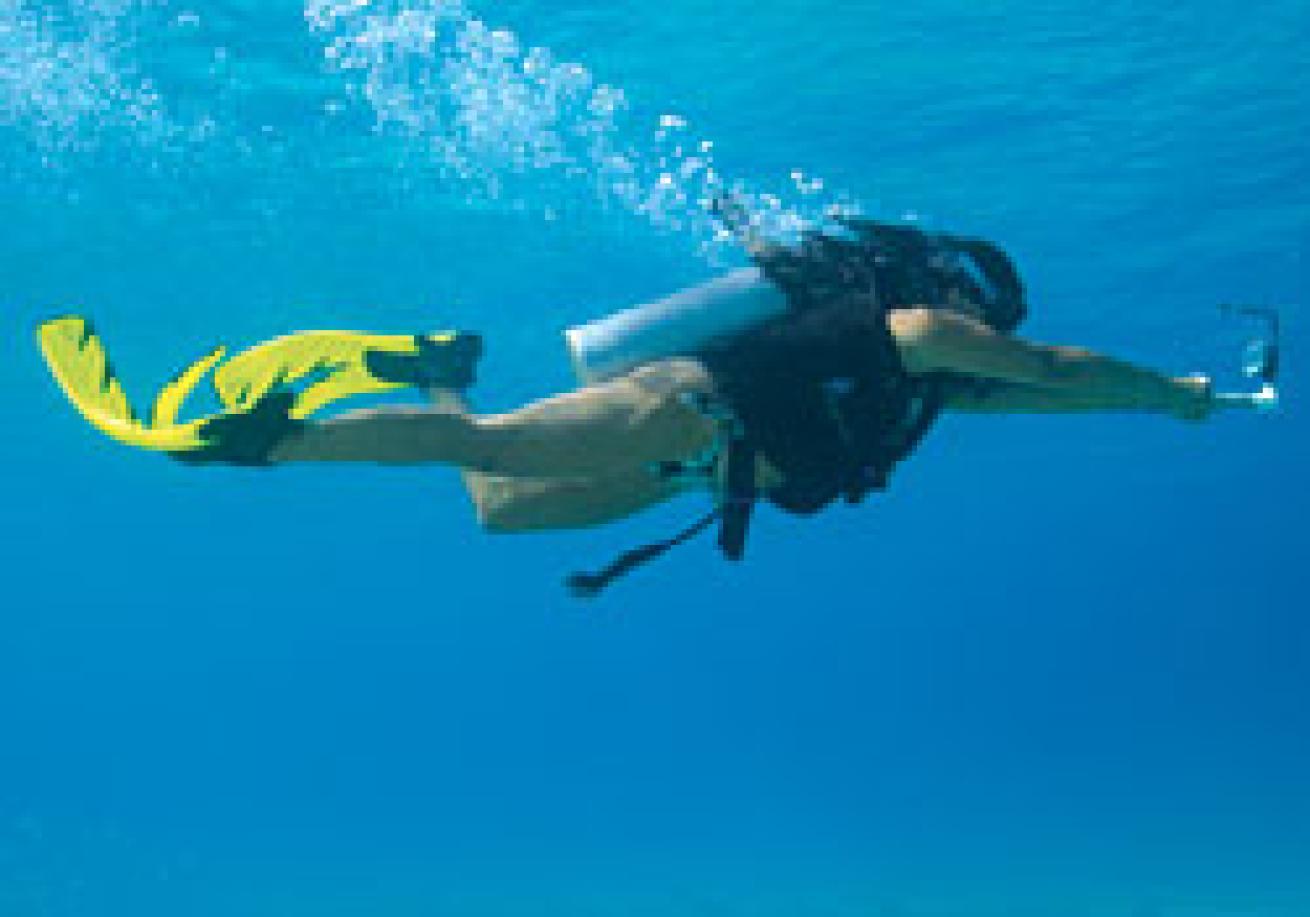
| | Test diver Riza Lacour burns up the speed course, measuring a fin's top speed with a digital underwater speedometer.|
This year's test bed included a total of 16 fins: 10 open-heel models and six full-foots. Most were either new, redesigned or rebranded since last year's tests; a few fins were not new but had never been reviewed before. For comparison, we also included a couple of classic fin designs that have been around as long as many divers have been alive. We wanted to see if they could compete, kick for kick, with the latest in fin technology.
A Full Test Schedule
Tests were comprised of rigorous morning objective tests, followed by afternoon ergonomic dives out on the reefs. Morning tests included speed runs with specially designed underwater digital speedometers, thrust tests using a kicking harness attached to a spring-loaded scale, slalom runs conducted on a staked course, and straight-line efficiency course runs timed with digital stopwatches. Afternoon dives gauged how the fins behaved in real-world diving situations. Test divers used preprinted waterproof test sheets on underwater slates to score each fin in 10 specific performance categories--how a fin maneuvered down on the reef, how stable it was when kicking hard, how comfortably it fit, etc.--then supplemented their scores with written comments.
By week's end, we'd put in a total of 195 underwater hours on the objective tests alone, and collected 1,920 data points. And our divers collectively made another 180 afternoon dives, generating 1,800 additional data points and pages of written comments.
Following is a rundown of what we discovered.
Open-Heel Fins - Testers' Choices
This year's four top open-heel kickers ran well ahead of their rivals in the "most important" ergonomic tests. Combined with Good to Excellent scores on the objective performance measurements, these fins earned the highest total scores in their class.
APOLLO SPORTS Bio-Fin Pro Yellow/C-Series
|| |---|
|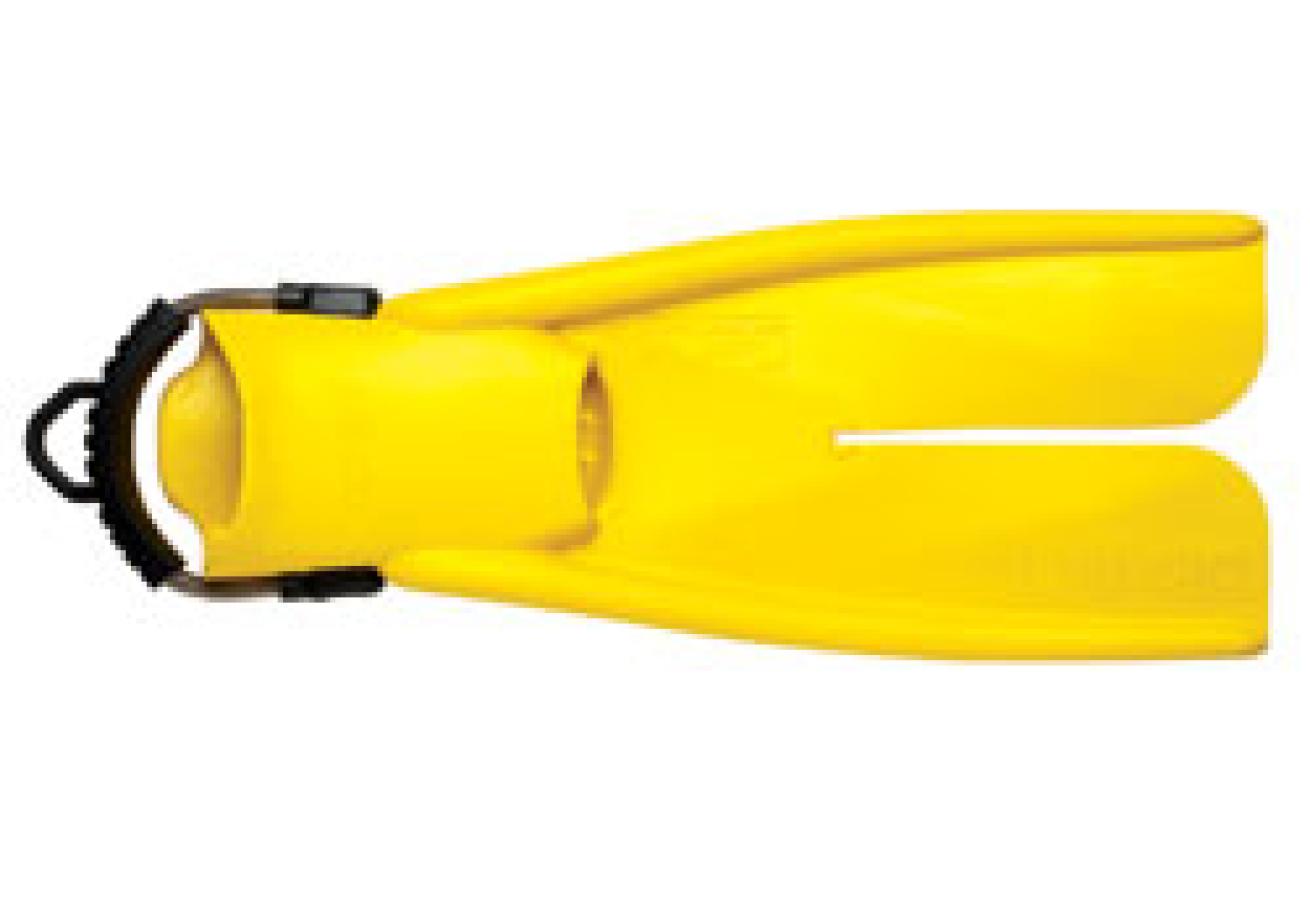
| | APOLLO SPORTS Bio-Fin Pro Yellow/C-Series|
The fin itself is equally impressive. Its 100 percent natural rubber construction provides a butter-soft foot pocket that feels molded to your foot. It's the only fin in this year's competition to earn an Excellent rating for comfort. But while it may fit like a favorite slipper, it doesn't behave like one. The Bio-Fin Pro Yellow/C-Series outraced all comers on the speed test, muscled top score out of the thrust test and easily dusted the competition on both slalom and efficiency courses.
When test divers took it out for some real-world diving, it dominated there too. Generating snorkel-bending acceleration, stability at high speeds and a nimbleness that had everybody talking, this pliable fin racked up the highest total ergo score. As the only open-heel fin rated Excellent for power, for acceleration, for its efficiency with alternate kicks, as well as for comfort, it's easy to see why the Bio-Fin Pro Yellow/C-Series is this year's top overall open-heel fin.
Test Divers' Comments:_ "Spring straps make an already great fin even better." ... "This is the closest man is allowed to come to being a fish." ... "If these fins had reclining seats I'd trade my Jaguar in for a pair." ... "Very comfortable and no leg strain at all--even when swimming fast."_
AERIS Velocity Duo
|| |---|
|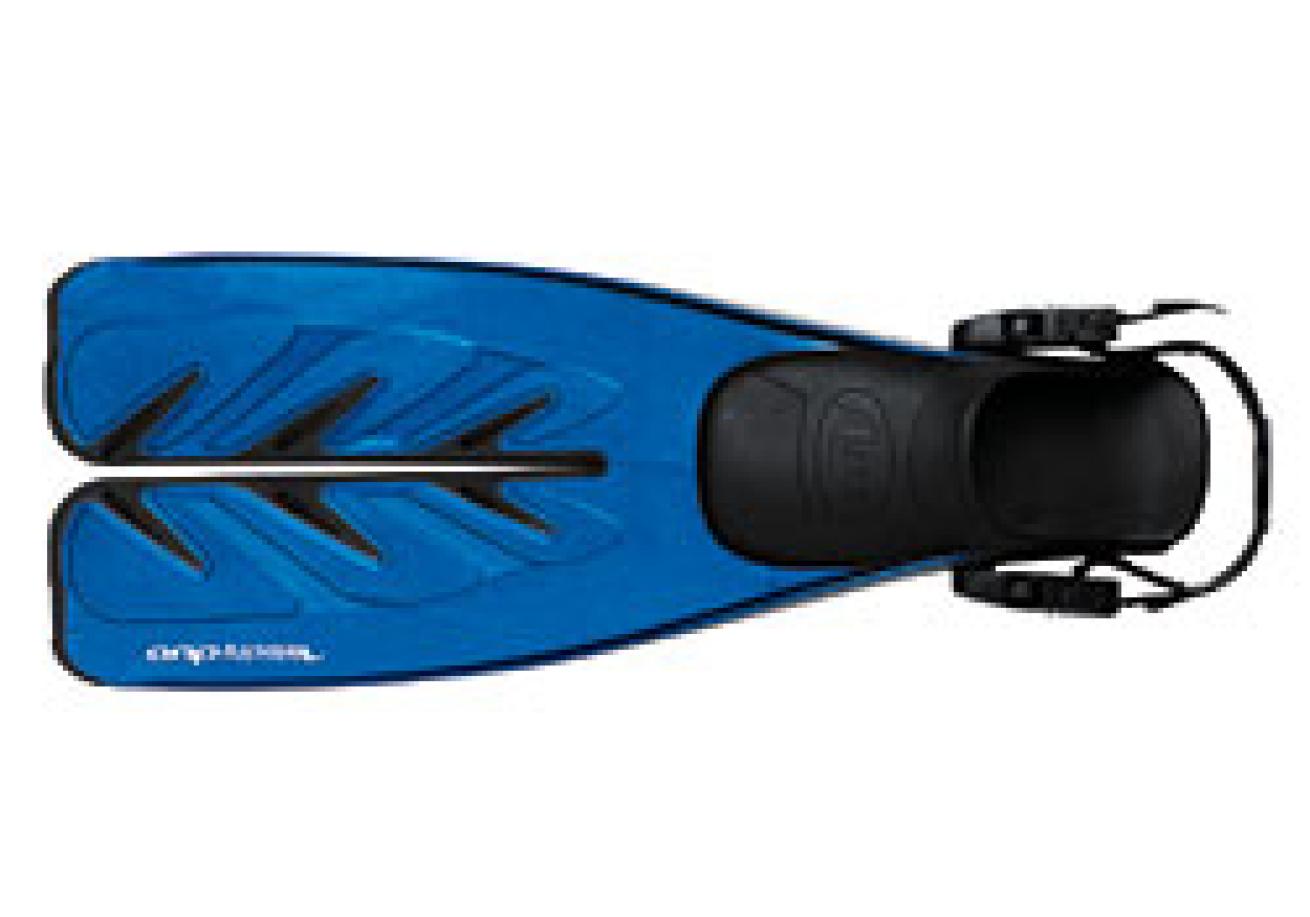
| | AERIS Velocity Duo|
It's out on the reefs where the Velocity Duo really hits its stride. Earning the second-highest overall score for ergonomics, test divers rated it Very Good in all the "most important" performance categories. The fin proved to be stable and maneuverable. It responded well to small corrections and could easily hold a diver in a stationary position for photography. It also showed itself to be a very good fin for alternate kicks, the frog kick in particular, and it can move some water when kicking on the surface. As far as comfort, while male test divers tended to be satisfied with the foot pocket, some female divers felt that it was a bit too wide for their feet, which created wobble. Except for that, the Velocity Duo was considered by all test divers to be an exceptional all-around reef fin.
Test Divers' Comments:_ "Reminds me of a comfortable pair of running shoes." ... "Very lightweight. Easy to use." ... "Comfy. Hard to tell I had fins on." ... "Good on the surface when kicking on the stomach." ... "Delivers the kicking ease of a split with the stiffness of a blade."_
MOR-FIN Blue VT-300B
|| |---|
|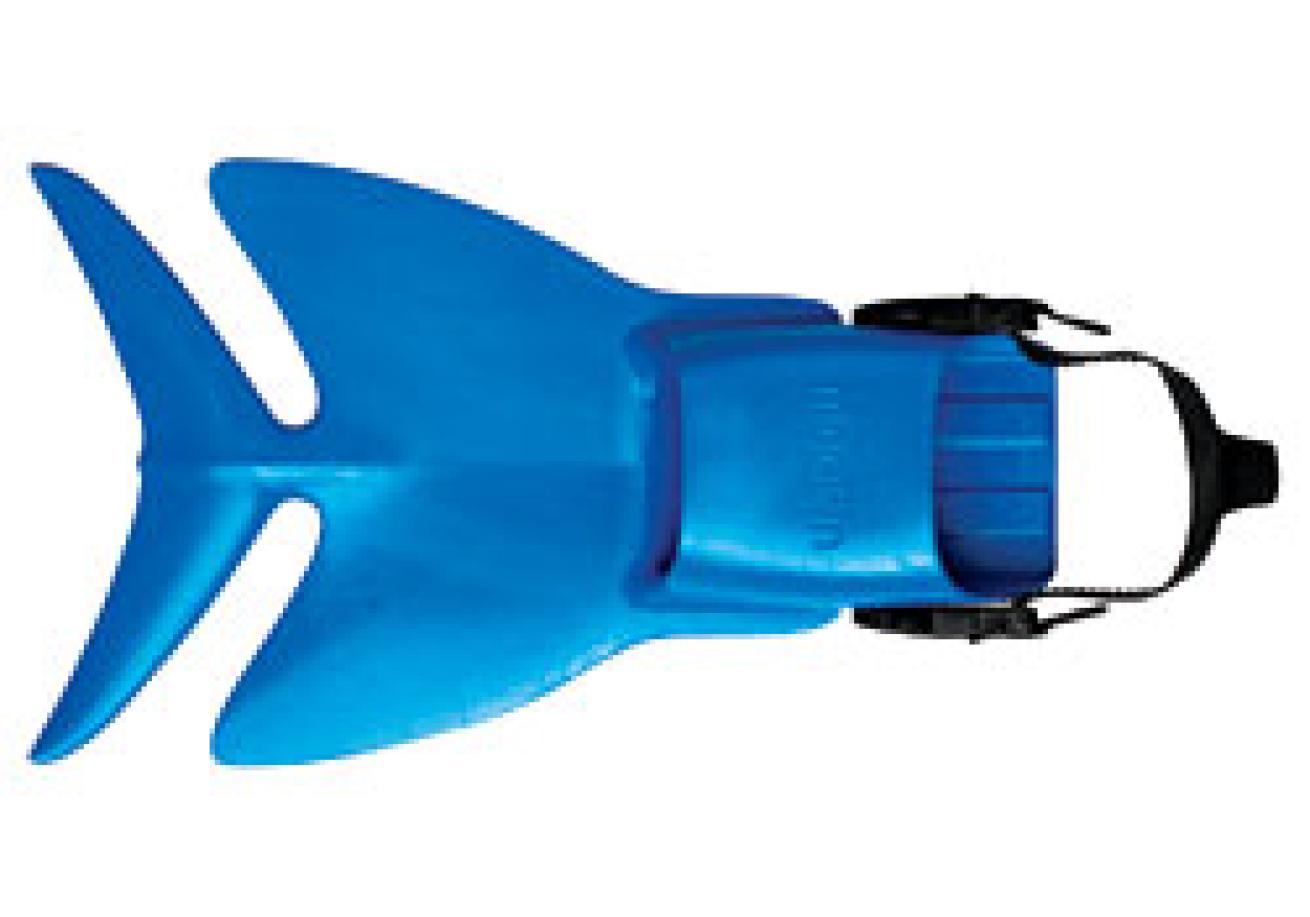
| | MOR-FIN Blue VT-300B |
On the downside, the fin was dinged by some test divers who found the foot pocket too stiff. Also, the blades are slick and a little sharp-edged, making them tricky to hold onto at the surface. (Note: Mor-Fin is already in the process of making the fin with a less slippery surface.) Finally, the fin doesn't really have any nonskid--not the best situation on a wet boat deck. According to Mor-Fin, they're working on that too.
Mor-Fins come in three levels of stiffness, designated by color. The stiffest and most powerful are black, the softest and most pliable are yellow, and the blue falls right about in the middle. Mor-Fins are available in medium and extra-large, but more sizes are slated for the future.
Test Divers' Comments:_ "Feels really light and easy to kick." ... "Good for dolphin and frog kick." ... "Pretty nimble. Good maneuverability." ... "This fin does have some power." ... "Surprisingly efficient." ... "Good cruising fins." ... "Is it just me, or are these things funny-looking?"_
DEEP OUTDOORS Six-Gill
|| |---|
|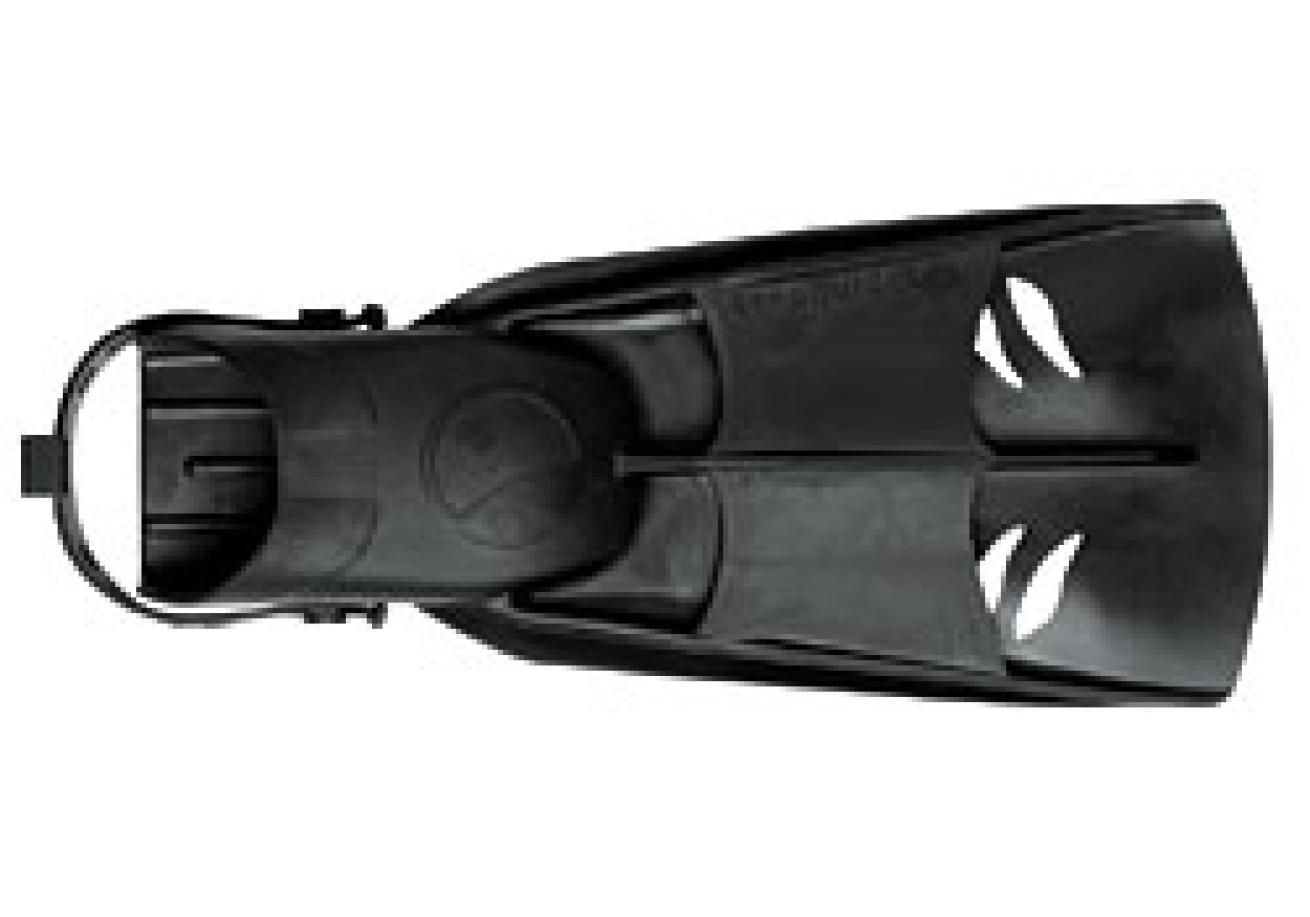
| | DEEP OUTDOORS Six-Gill |
The Six-Gill delivered mid-range results out on the objective test courses, then racked up the third-highest ergonomic score in this year's face-off. Test divers particularly liked its short, easy-to-wield blades, enabling them to get close to reefs while maintaining perfect control to avoid accidental contact with coral heads. It also proved to be a very stable fin, and a natural for divers partial to frog and dolphin kicks. However, the fin's nonskid provides only marginal traction on a wet boat deck.
The Six-Gill uses a super-simple strap system that eschews buckles. Pick the right adjustment slot on the strap, pop it over the fin post, and you're good to go. This system makes it hard to readjust while at depth, but if you did it right to begin with, you shouldn't ever have to readjust it under water. Test divers found the foot pocket to be very comfortable, in spite of the fact that at the time of testing it was available only in medium/large. Deep Outdoors says small/medium and large/extra-large sizes should be available by the time you read this.
Test Divers' Comments:_ "Straps are efficient--I like them." ... "Fins are shorter than average, which makes them easy to use." ... "I thought at first the straps were a little awkward, but they ended up working pretty well." ..."Very decent fin." ... "Good fin for the frog kick."_
Open-Heel Fins - Very Good Performers
Although these fins didn't earn enough points to earn a Testers' Choice designation, XS Scuba's Power Fin did deliver above-average performance in stability, comfort and alternate kicks, while Sherwood's Kinesis fins excelled in stability, donning/doffing and adjustment. Objective scores ranged from Fair to Very Good. The Power Fin also tied for highest thrust score.
XS SCUBA Power Fin
|| |---|
|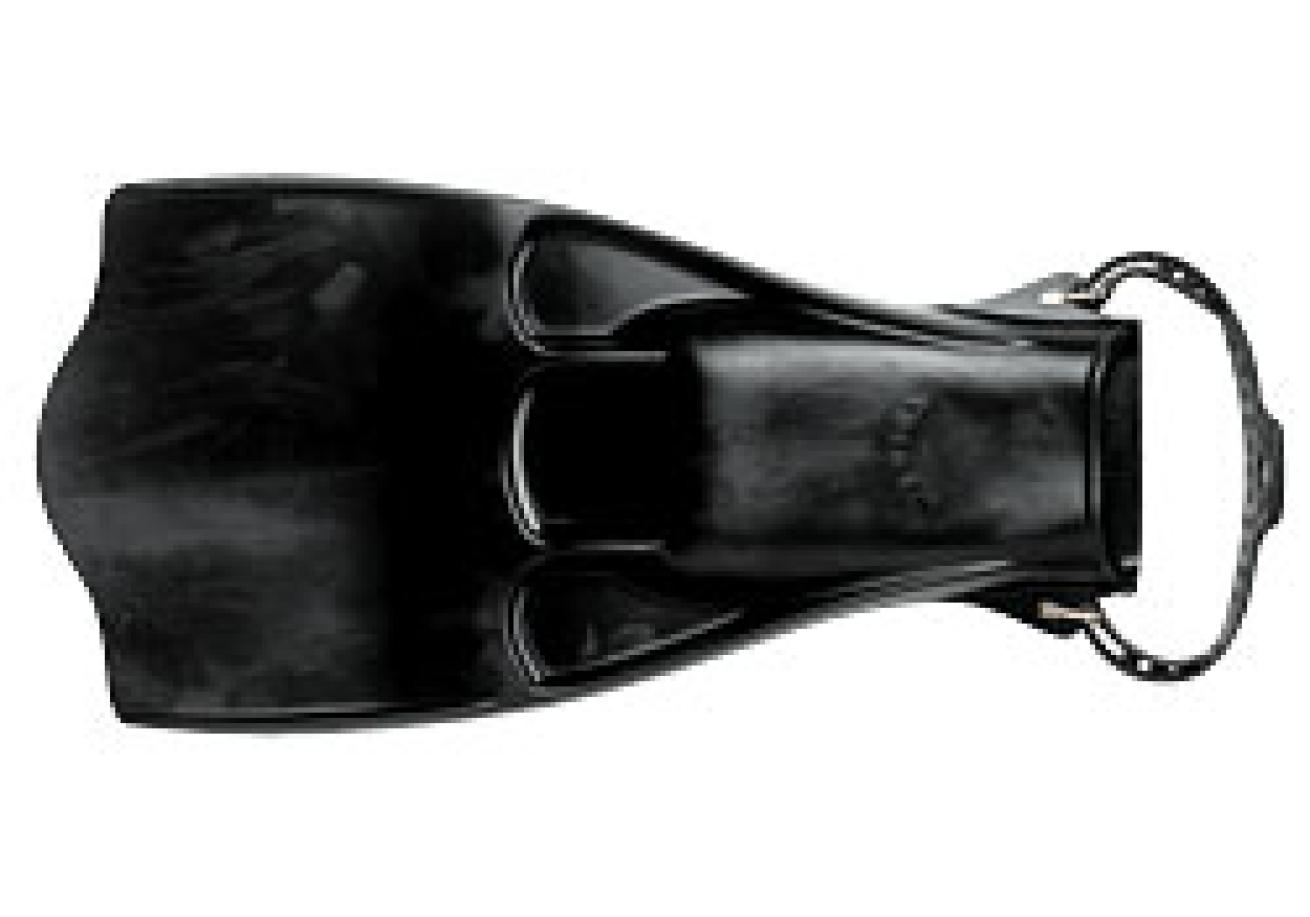
| | XS SCUBA Power Fin |
Boy, were we surprised. First it pumped out a Very Good score for speed runs and also on the efficiency course, then collected a Fair score on the slalom course, then kicked into turbo mode to tie for the highest score in the thrust test. Out in real-world diving, test divers who've been blowing bubbles for a couple decades or more simply loved this fin. Newer divers, however, tended to be put off by the squat, relatively heavy, all-rubber design. But almost all test divers agreed that the Power Fin can get the job done. The fin is very stable at depth, offers good blade-end snap, and does exceptionally well with alternate kicks. Divers with cameras felt it was, as one put it, "super-easy to back up and maneuver when taking photos." The foot pocket is soft and comfortable, but the old-style strap system can be difficult to adjust. The upside is that once it's adjusted it stays adjusted, and there's nothing plastic to lose or break. The Power Fin's Very Good overall performance relative to price makes it a Best Buy.
Test Divers' Comments:_ "Of the entire grab bag of available fins, these are near the top." ... "These fins are heavy, no need for wearing weights." ... "Love these fins." ... "Dependable strap, but not easy to adjust." ... "Surprisingly good fin overall." _
SHERWOOD Kinesis and Kinesis EX
|| |---|
|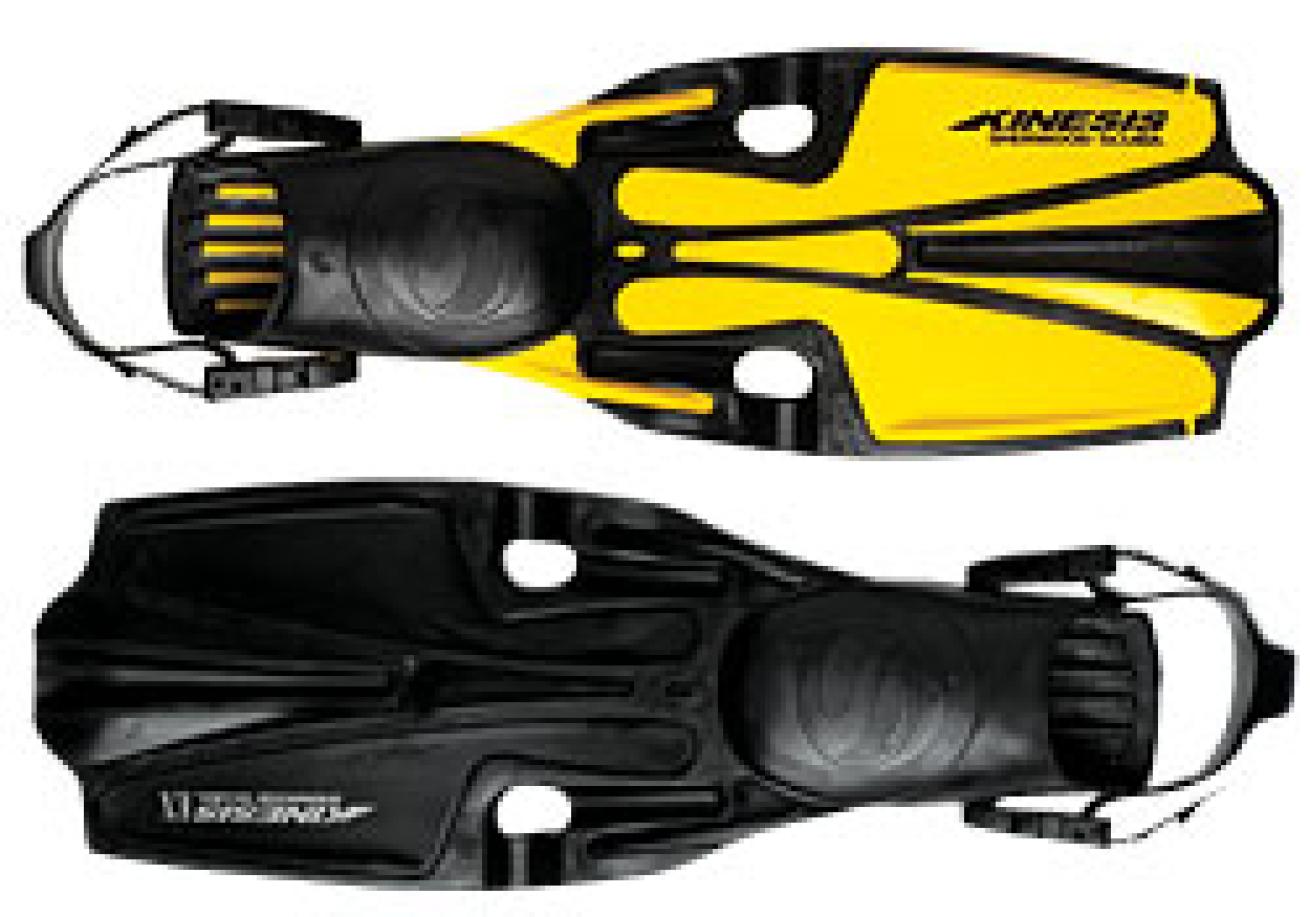
| | SHERWOOD Kinesis and Kinesis EX |
The two fins turned in decent straightaway speeds and did well on the efficiency course. Comparing the two fins to each other, the more flexible blade gave the standard Kinesis a slight advantage on the slalom course. When measuring thrust, the stiffer blade gave the EX a slight edge; however, compared to other fins, neither Kinesis was able to exert much force in the thrust test.
Out diving the reefs and cruising blue water, both fins proved to be very stable and comfortable. However, when test divers tried to turn on the kicking heat, they found it was easy to overstress their leg muscles. Some test divers found the blades a bit too long for maneuvering in close around reefs, but other test divers had no problem controlling the blades. All divers agreed that the fins were a cinch to get on and off, and they adjusted easily. Female test divers with smaller feet did find the foot pockets to be a bit too wide relative to their length, which caused some wobble.
Test Divers' Comments:_ "Decent fin for cruising." ... "Good on surface swims." ... "It's a pretty stiff blade--it strains the foot top and ankle." ... "It feels like you're kicking hard, but not moving very fast." ... "Efficient buckle system." ... "Overall, not a bad fin."_
Open-Heel Fins - Good Performers
These fins delivered satisfactory performance on the ergo dives, with the Aqua Lung Caravelle excelling in fit and comfort, the Dive Rite Fin excelling in donning and doffing with its spring strap, and the IST F-2 Talaria excelling in straight-line stability.
AQUA LUNG Caravelle ADJ
|| |---|
|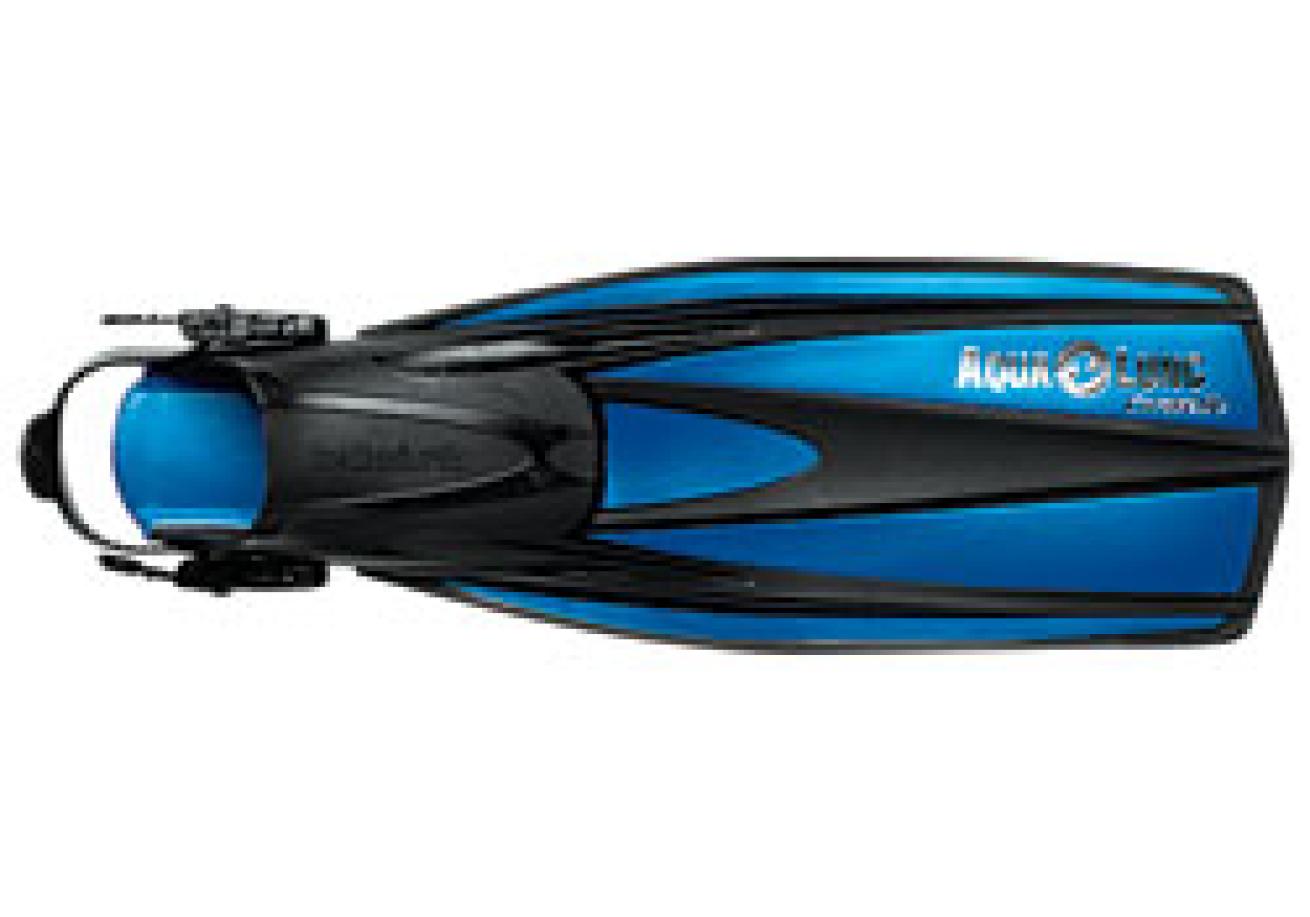
| | AQUA LUNG Caravelle ADJ |
The Caravelle ADJ is not a bad fin out on the reefs. It turned in solid scores in the most important performance categories, plus was deemed to be above-average for fit and comfort. Divers also liked the easy buckle system, the extended heel and the nonskid.
Test Divers' Comments:_ "A bit of a long blade. You have to get used to it, but then it really is a nice fin." ... "Seems to go better with a slower, wider kicking stroke." ... "I find these fins very comfortable." ... "I like that they are lightweight."_
DIVE RITE Fin
|| |---|
|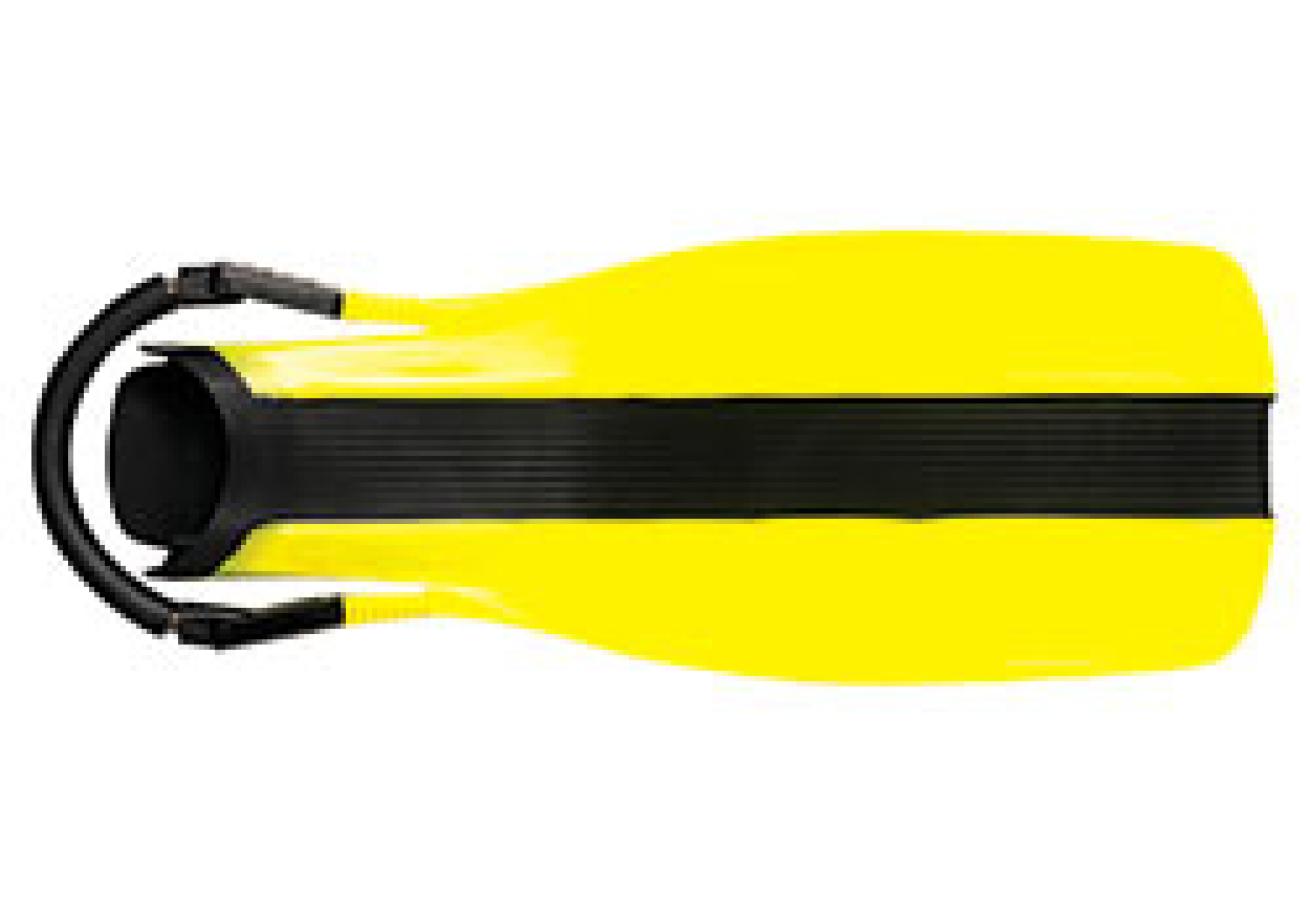
| | DIVE RITE Fin |
Test Divers' Comments: _"Spring strap is nice." ... "These fins hurt my ankles and feel like two steel plates on my feet." ... "Feels a bit clunky, but it's nimble." _
IST F-2 Talaria
|| |---|
|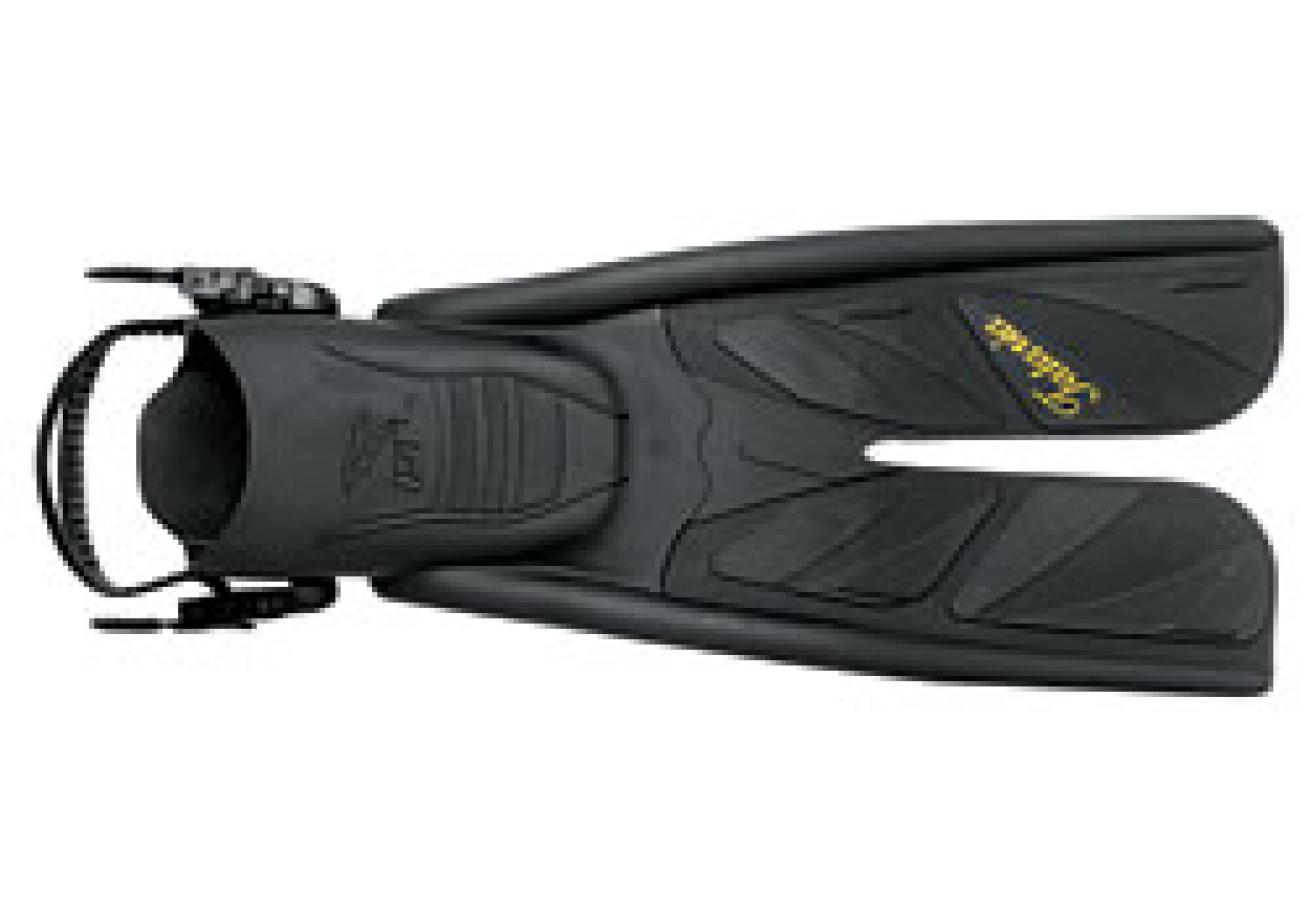
| | IST F-2 Talaria |
Test Divers' Comments: _"Easy fin to use." ... "Soft, mushy thrust." ... "Rubber fin has nice weight characteristics." ... "Not so efficient in cornering, but not a bad fin." _
Full-Foot Fins - Testers' Choices
These two ferocious full-foots were consistent front-runners on this year's test courses. Both turned in across-the-board Very Good performance in ergonomics, with Atomic Aquatics scoring an Excellent for acceleration. In objective tests, it was Very Good to Excellent scores for Akona's Azione, while the Atomic turned in Excellent performance throughout.
ATOMIC AQUATICS Full-Foot Splitfin
|| |---|
|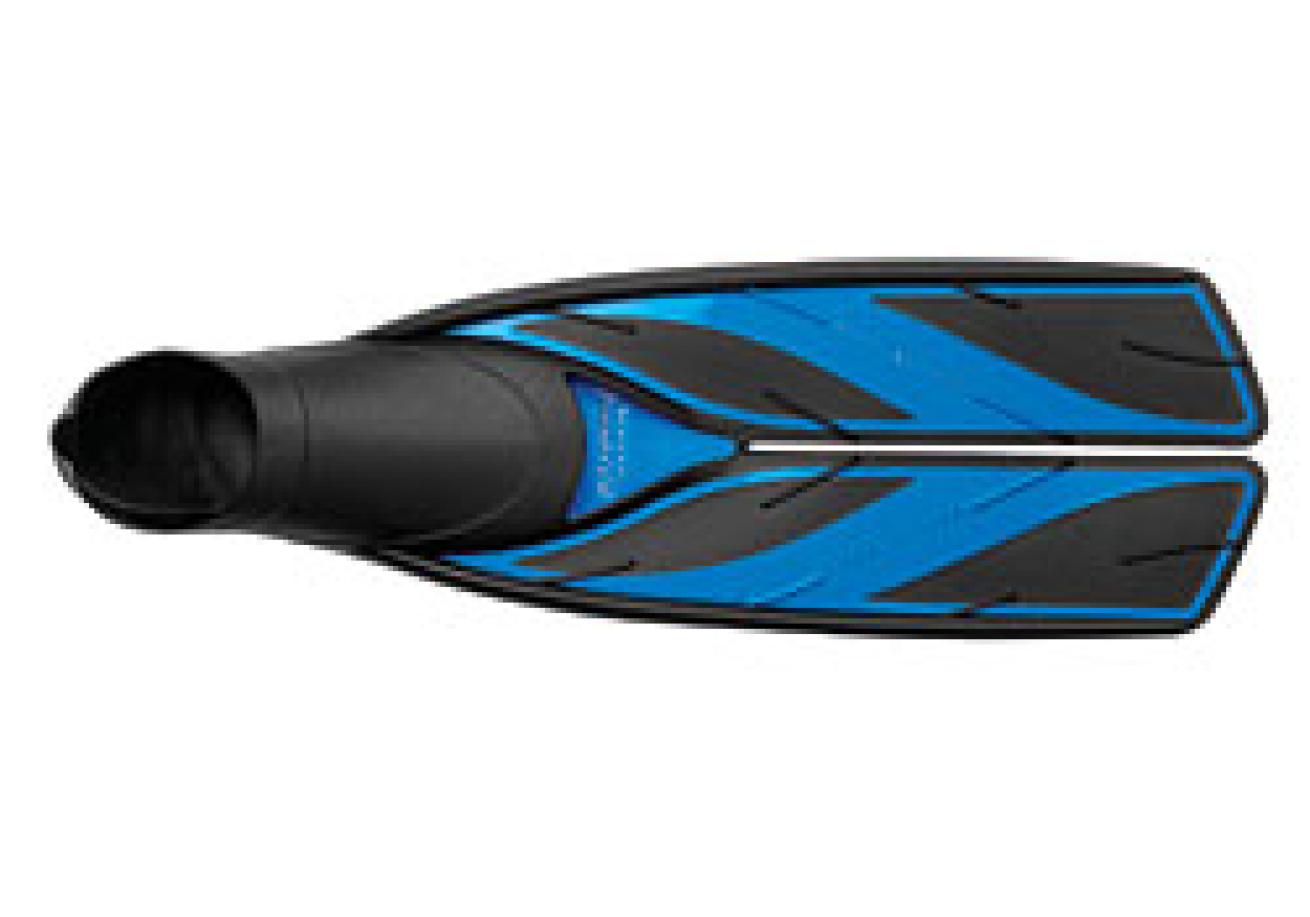
| | ATOMIC AQUATICS Full-Foot Splitfin |
So this year the fin returns touting twice as many size choices, an improved rubber composite for a softer, yet more durable foot pocket, and a new grade EVA material for more blade snap. The result: While enjoying only a slight uptick in speed over last year, the Full-Foot Splitfin dominated thrust tests, streaked around the slalom course like an overcaffeinated rabbit, and tied for top spot on the efficiency course.
But objective scores tell only half the story. Out on the reefs this is one sweet fin. The only full-foot fin rated Excellent for acceleration, it literally explodes out of the gate when you need that extra burst of speed. The fin is also very stable at high speeds. But going fast isn't all this fin does well; it's also a superb cruising fin, providing precise control close to reefs. As one test diver put it: "Great maneuverability, pinpoint control, dazzling acceleration, blinding speed, and comfortable too. What more could you want?" Test scores and diver comments concur--the Full-Foot Splitfin is the best overall full-foot fin of 2005.
Test Divers' Comments: "I think I'm in love." ... "Fits like a $300 running shoe." ... "Perfect foot pocket." ... "My favorite fin yet." ... "Nice and light, a powerful fin." ... "The pick of the litter."
AKONA Azione
|| |---|
|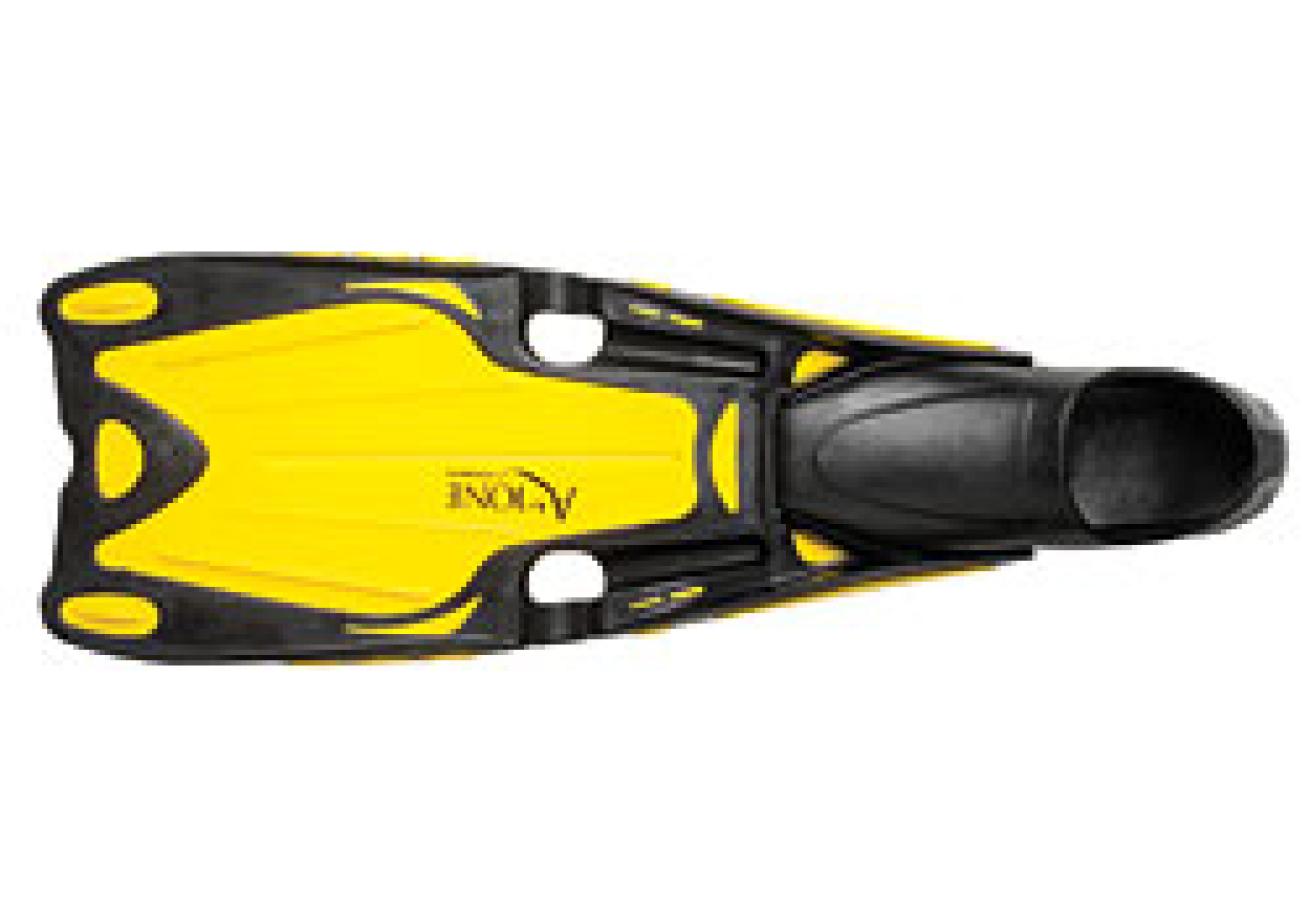
| | AKONA Azione |
Comfort was a big plus for the Azione. Foot pockets are, as one test diver described it, "As comfortable as wearing slippers." All test divers agreed the fin provided great fit and comfort, but female test divers in particular just loved this fin. Women with small feet found the foot pockets well-proportioned and very comfortable, providing a fit that translated into a powerful, wobble-free kick. This fin is fast, stable at depth, efficient on the surface, easy to get on and off, and as comfortable as they come. Overall, test divers deemed the Azione a great diving fin.
Test Divers' Comments:_ "Graceful performance with power, speed and comfort." ... "Super control. I love these fins." ... "These fins can pick up speed very quickly." ... "Good comfort. Nice flex when starting your kick." ... "Splendid control. Effortless movement." ... "Surprisingly fast. A great fin."_
Full-Foot Fins - Very Good Performers
While these two above-average fins pounded out near-identical scores for ergonomics, the Oceanic Vector edged ahead of the Apollo Sports Bio-Fin Uni Blue on the speed course, while the Uni edged out the Vector on the efficiency course.
APOLLO SPORTS Bio-Fin Uni Blue
|| |---|
|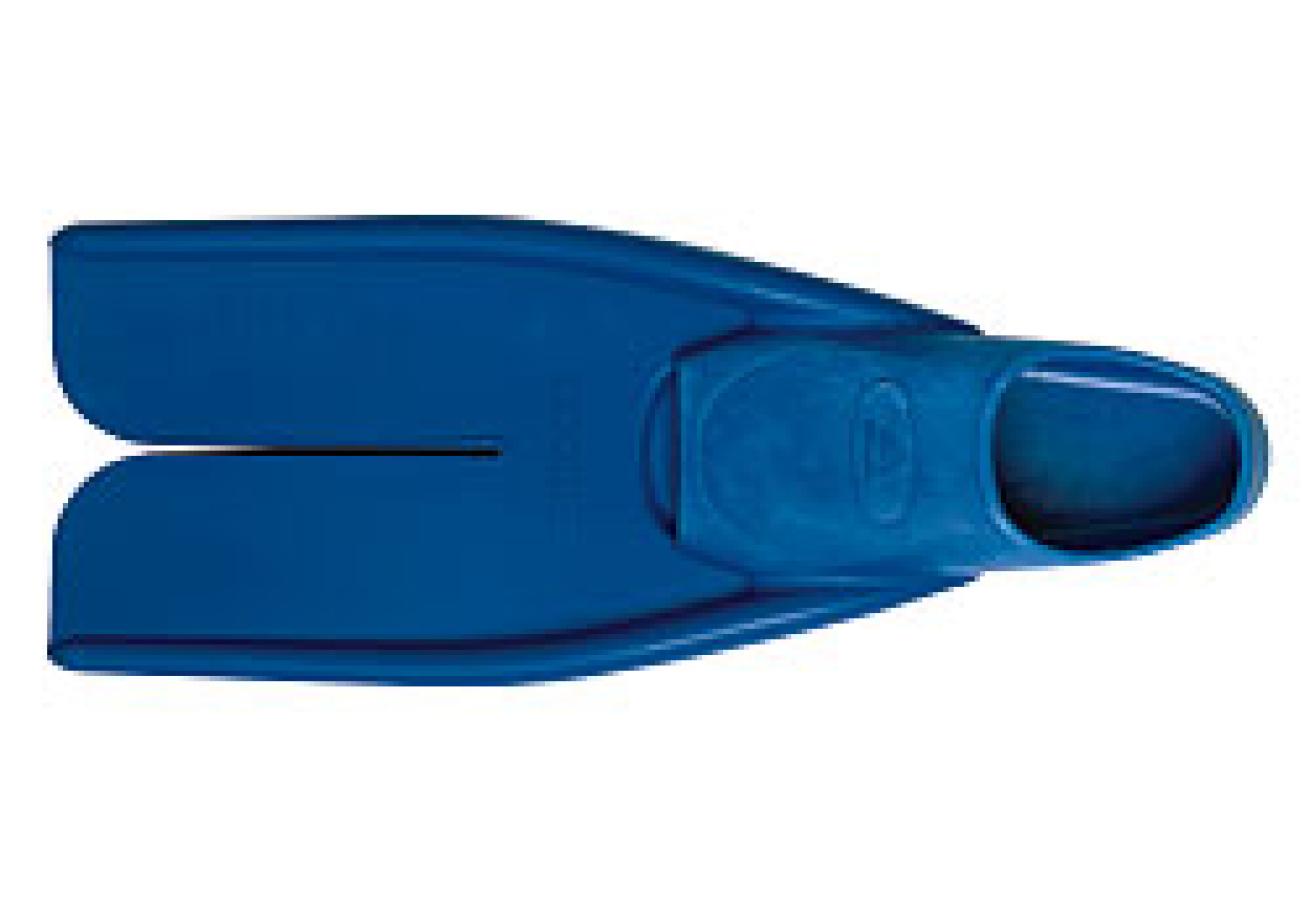
| | APOLLO SPORTS Bio-Fin Uni Blue |
In spite of the fit issues, test divers loved the Bio-Fin Uni Blue. The fin excelled in speed and thrust tests, was a real go-getter on the slalom course and tied for best score on the efficiency course. Made of 100 percent rubber, it's a pretty heavy fin for a full-foot, but it's still quick and nimble down among the reefs and was deemed perfect for taking macro photos, for hovering while shooting video or for chasing eagle rays.
Test Divers' Comments:_ "Very comfortable foot pocket, but sized for men, not women." ... "I love these fins." ... "Soft foot pocket, just way too large." ... "Easy to hover and shoot video." _
OCEANIC Vector
|| |---|
|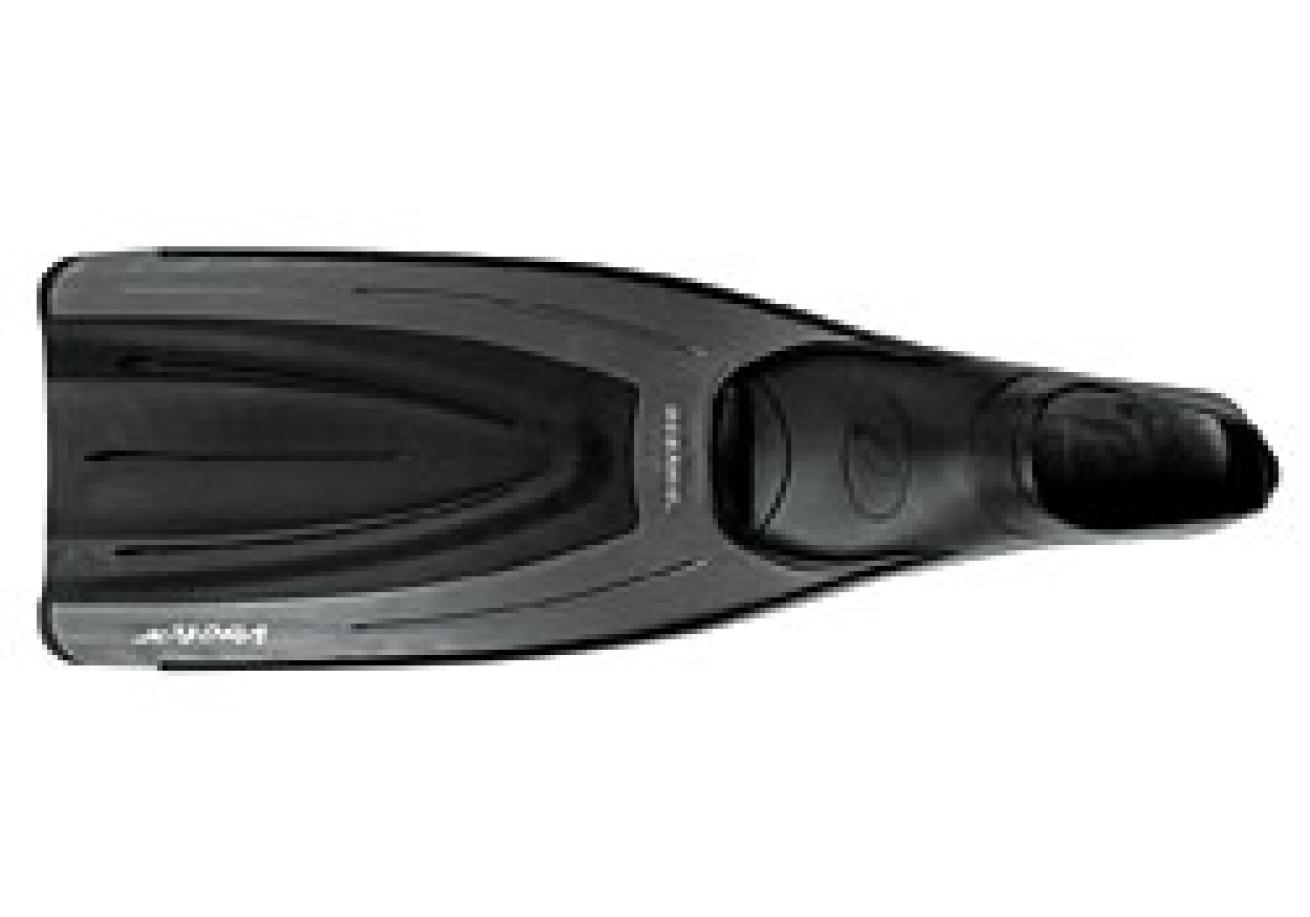
| | OCEANIC Vector |
The Vector is available in seven sizes. However, while half the test divers raved about the comfort of the foot pocket, the other half panned it. This didn't break along gender lines; it was more a foot-shape issue. The main complaint: The foot pocket is too narrow at the toe, causing pinching and rubbing. So divers with wide feet, beware. This fin carries a very reasonable price tag, so if your foot is the right shape for the foot pocket, the Vector's very good performance and a very good price make it a Best Buy.
Test Divers' Comments:_ "Somewhat constricting on the toes." ... "Very comfortable and lightweight." ... "Easy to turn and maneuver." ... "The foot pocket is too narrow. Pinched my toes." ... "If they fit my foot they would be great." ... "Super comfy. Love them." _
Full-Foot Fins - Good Performers
These two full-foot fins delivered respectable performance on the ergo course, and turned in objective test results ranging from Good to Very Good.
IST F-10 Pegasus
|| |---|
|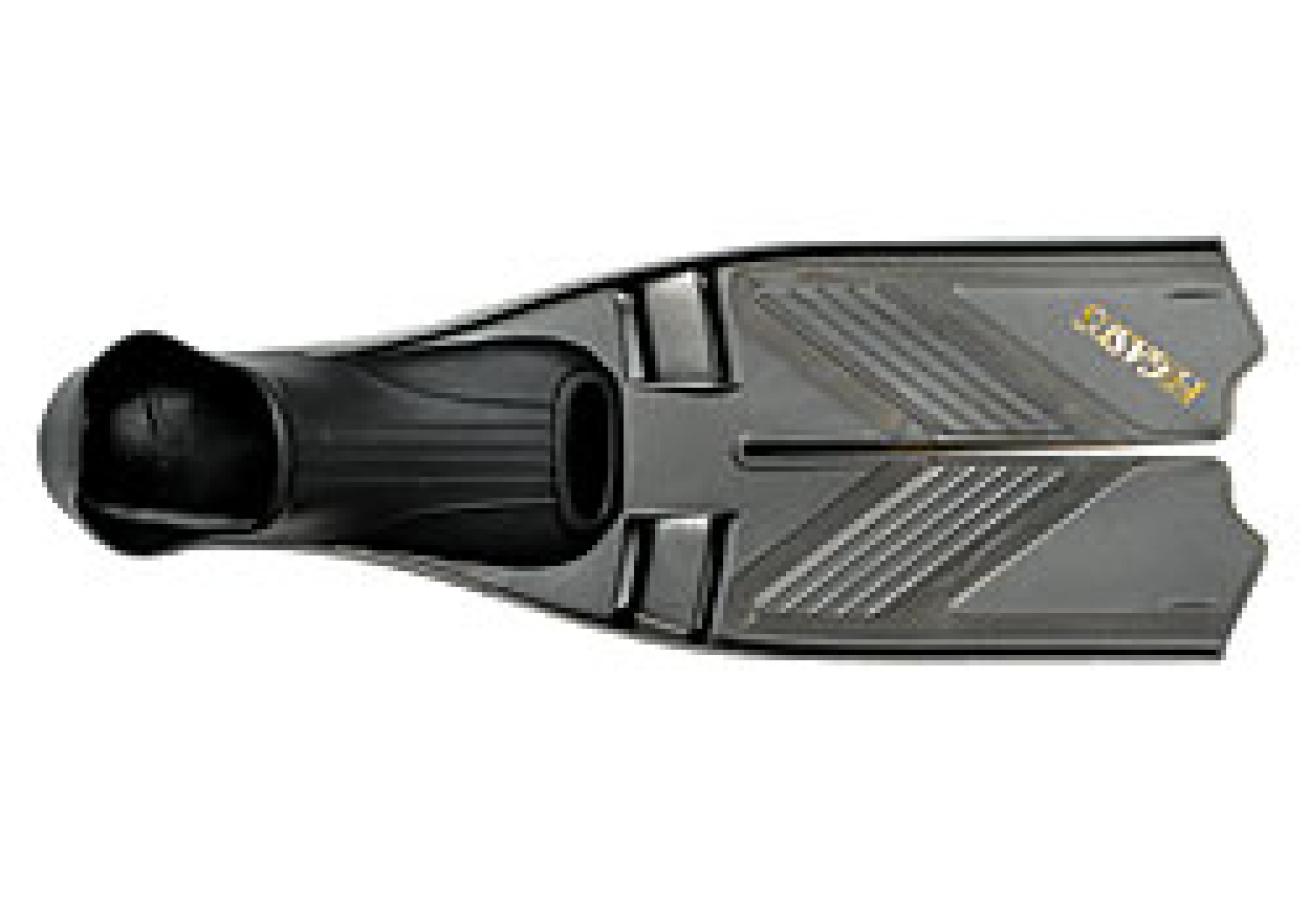
| | IST F-10 Pegasus |
Test Divers' Comments:_ "These fins would benefit from being a tiny bit more rigid." ... "They seem to lose power on the stronger kicks." ... "Comfort-wise, you barely notice they're on." ... "Too flimsy for serious maneuvering." ... "Comfortable foot pocket." ... "Nice fin, but flimsy." _
SEAC SUB Hyper-X
|| |---|
|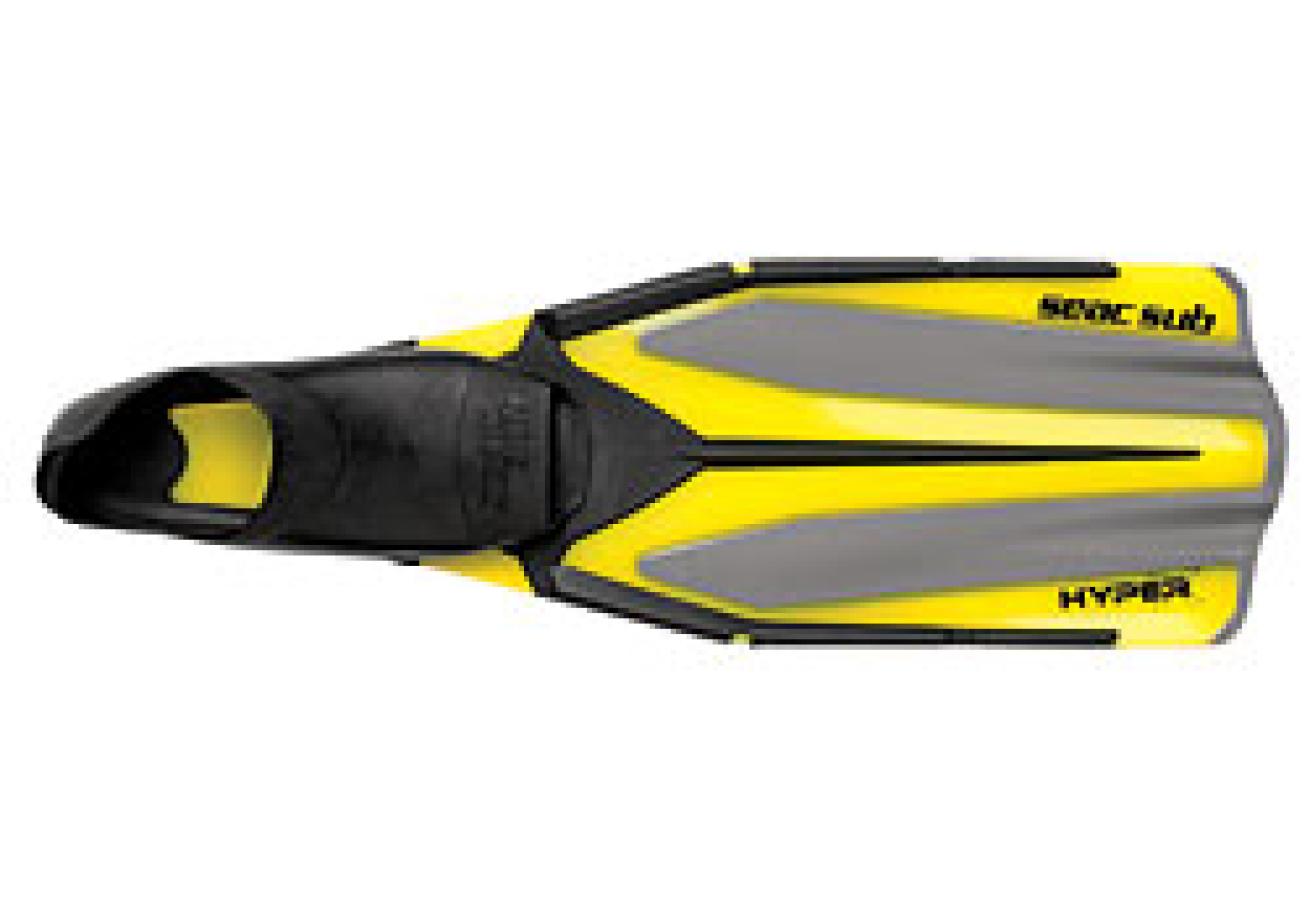
| | SEAC SUB Hyper-X |
Test Divers' Comments:_ "Blade too long for my tastes. Hard to maneuver. Ankles got tired." ... "Down kick produced stress in knee." ... "Slow using the flutter kick and a bit wobbly." ... "Don't seem to have the snap needed for top performance." _
First Look
MARES Quattro Excel
|| |---|
|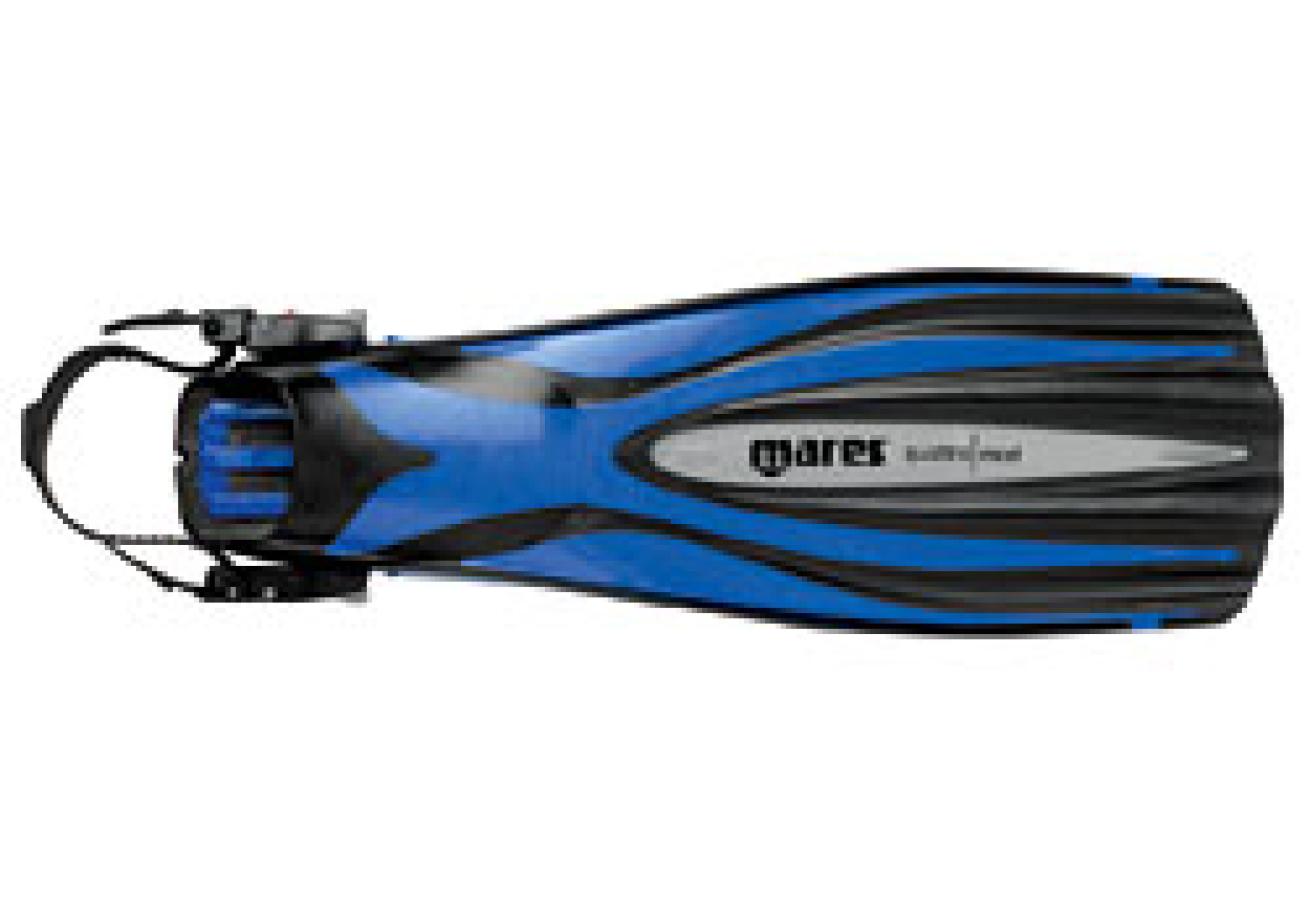
| | MARES Quattro Excel |
OMS Slipstream
|| |---|
|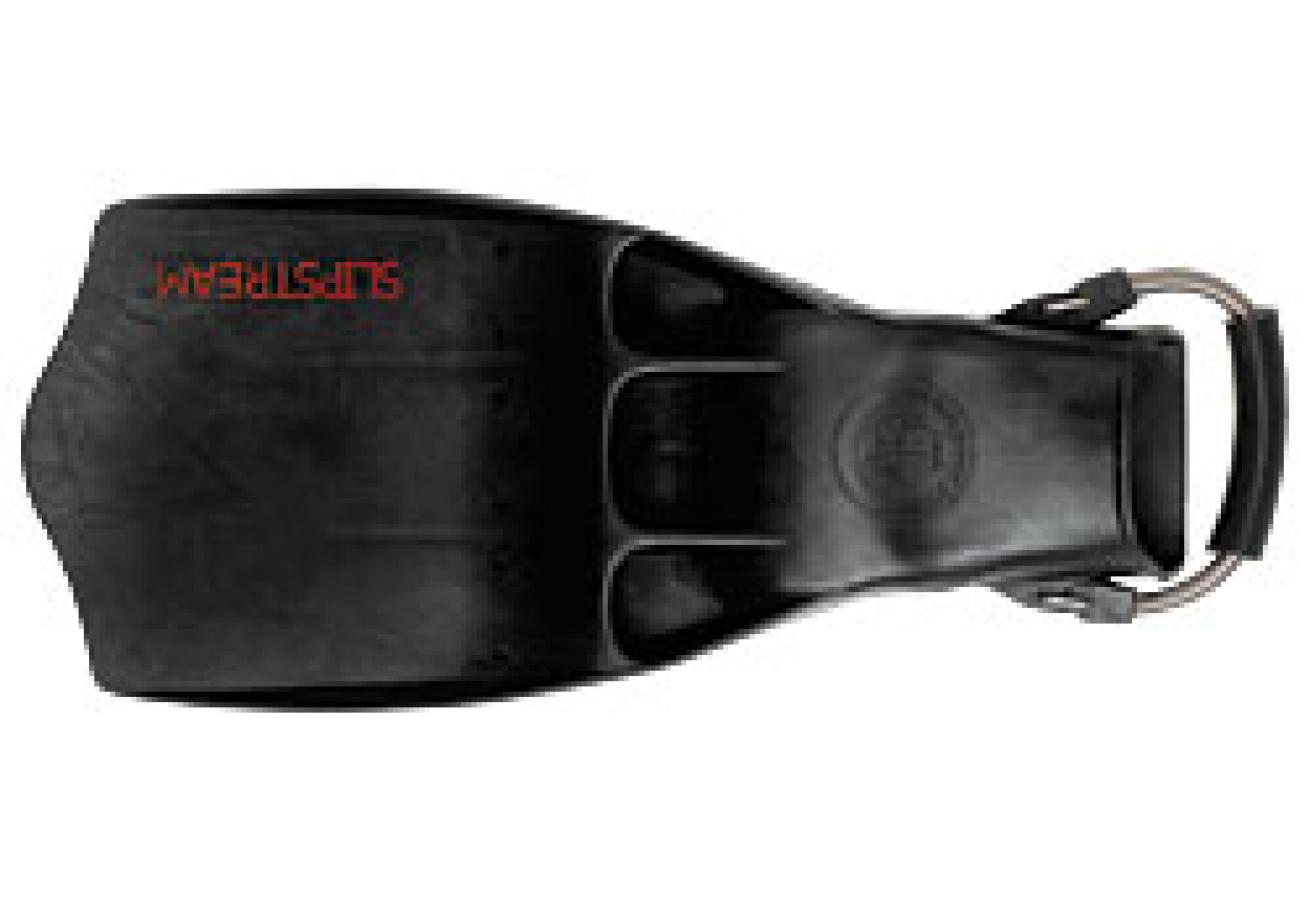
| | OMS Slipstream |
Our Thanks
|| |---|
|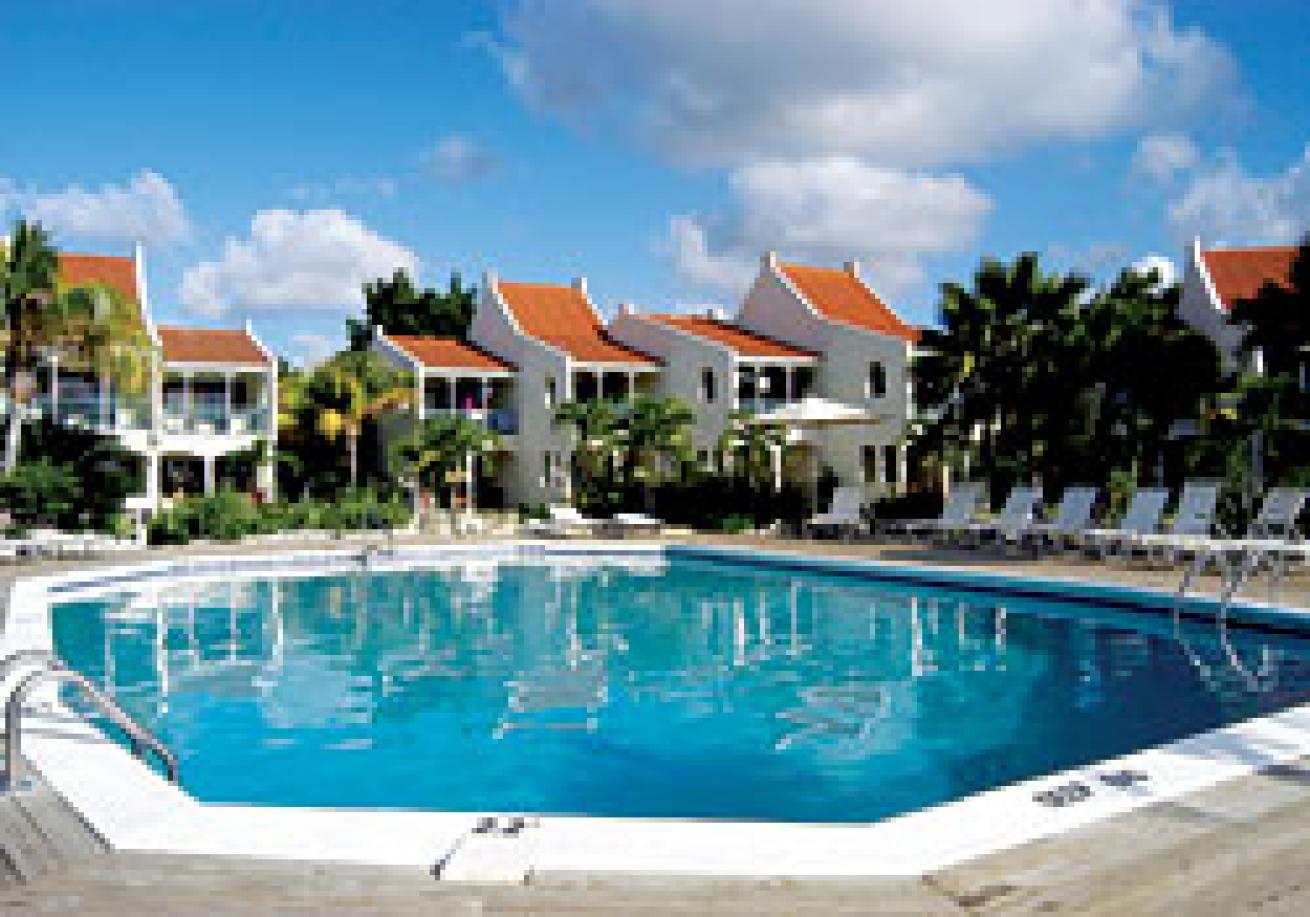
| | Photography by Jack Chalk |
2004 Tester's Choice
|| |---|
|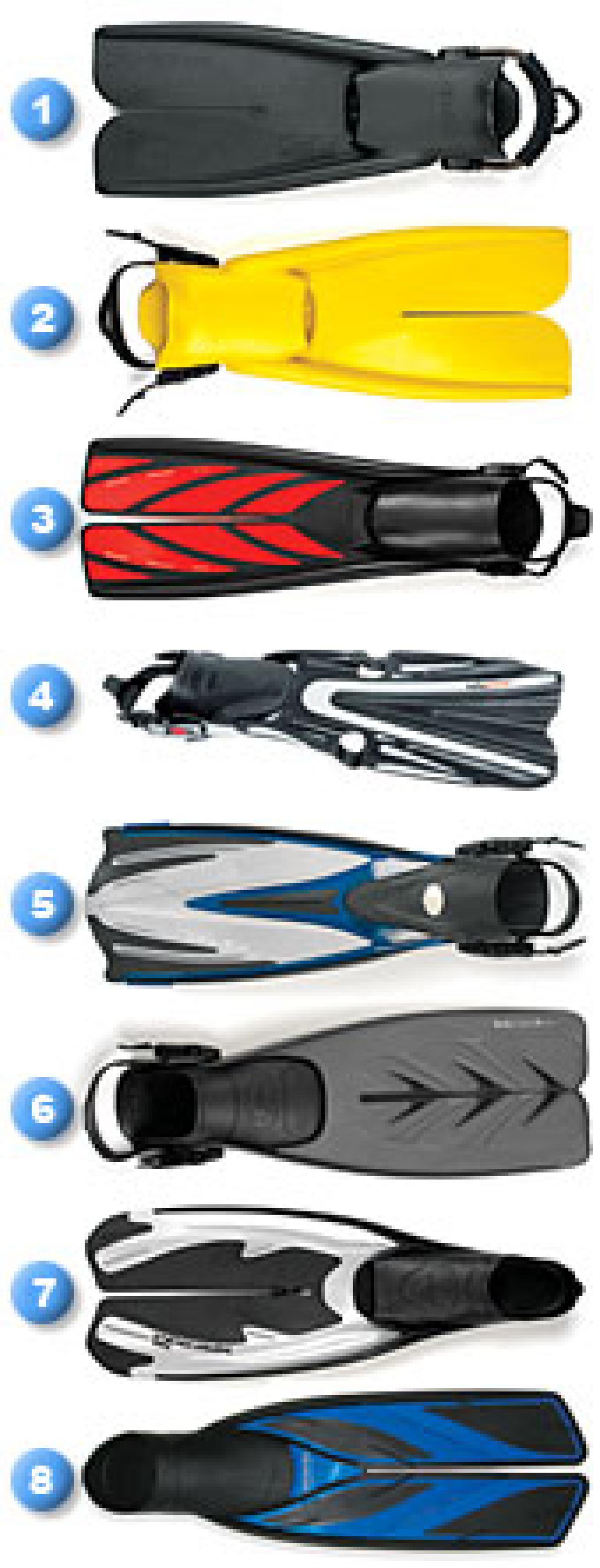
| | 2004 Fin Test |
Open-Heel Fins
(1) Apollo Sports Bio-Fin Pro XT/C-Series & (2) Apollo Sports Bio-Fin Pro Yellow. These heavy rubber split fins shared the title of 2004's best overall open-heel fin. The Bio-Fin Pro Yellow was revised for 2005. See main review, click here.
(3) Atomic Aquatics Reef Red. A proven split fin design with a longer-than-average blade that proved to be fast and maneuverable. Test divers also rated the EZ-Lok buckles as their favorite buckle system.
(4) Mares Volo Power. The updated version of the popular Volo paddle fin is fast, stable and highly maneuverable, thanks to a water-channeling system and the Optimized Pivoting Blade design.
(5) TUSA Imprex Tri-Ex. Lightweight, powerful and comfortable, this paddle fin was a favorite among test divers. And, thanks to a low retail price, it was a Best Buy.
(6) Aeris Velocity Duo. A lightweight split fin that was a great all-around performer, if a bit limited in top-end speed. Revised for 2005. See main review, click here.
Full-Foot Fins
(7) Tusa X-Pert Zoom FF-9. A compact split fin with a comfortable foot pocket that burned up the speed course and slalom courses en route to the title of best overall full-foot fin of 2004.
(8) Atomic Aquatics Full-Foot Splitfin. A narrow-blade split fin that was both fast and good-looking. Revised for 2005. See main review, click here.

